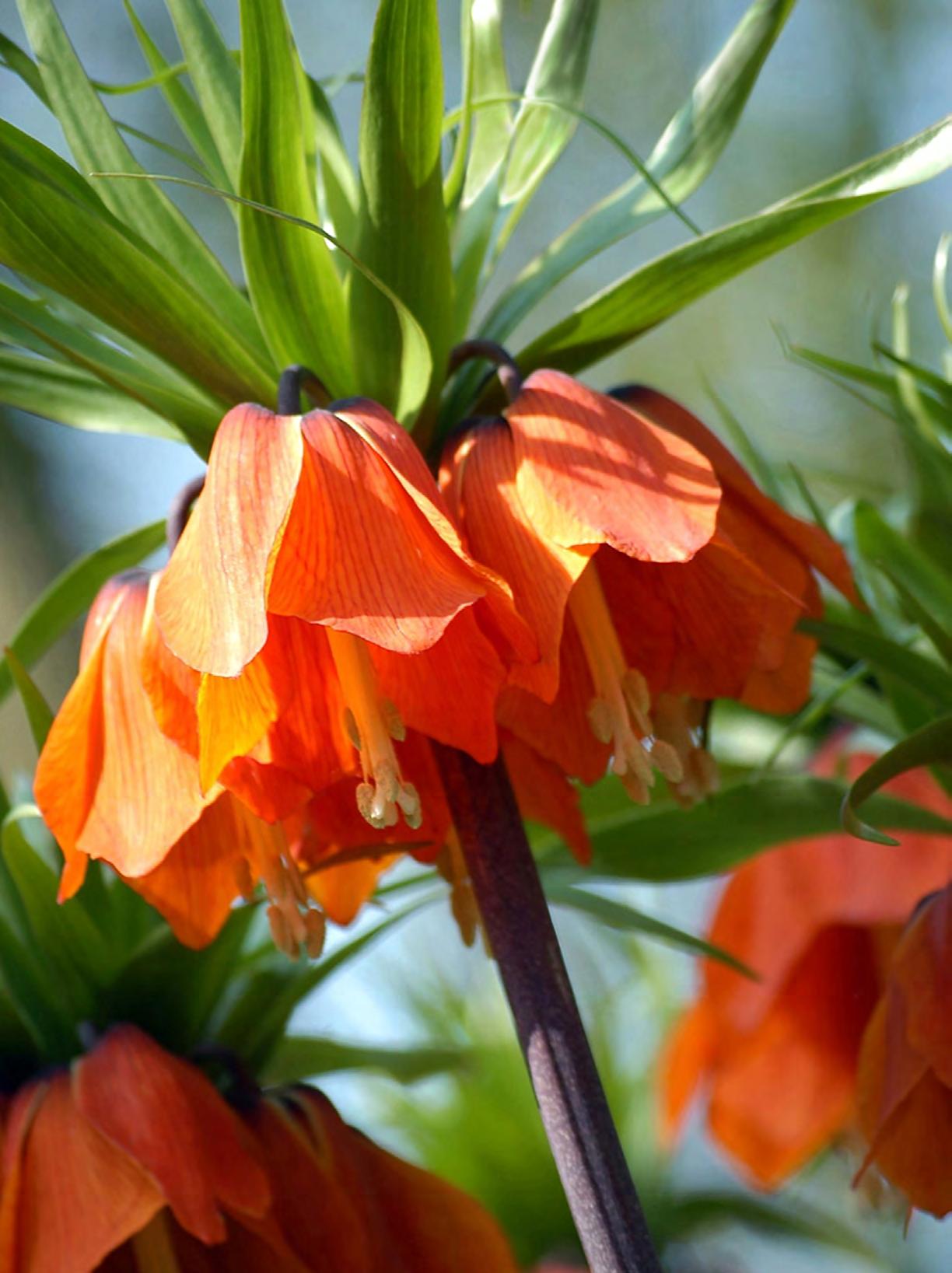
30,000 BULBS | GARDEN TRENDS | VERTICAL FOREST SPRING 2023 • VOL 52
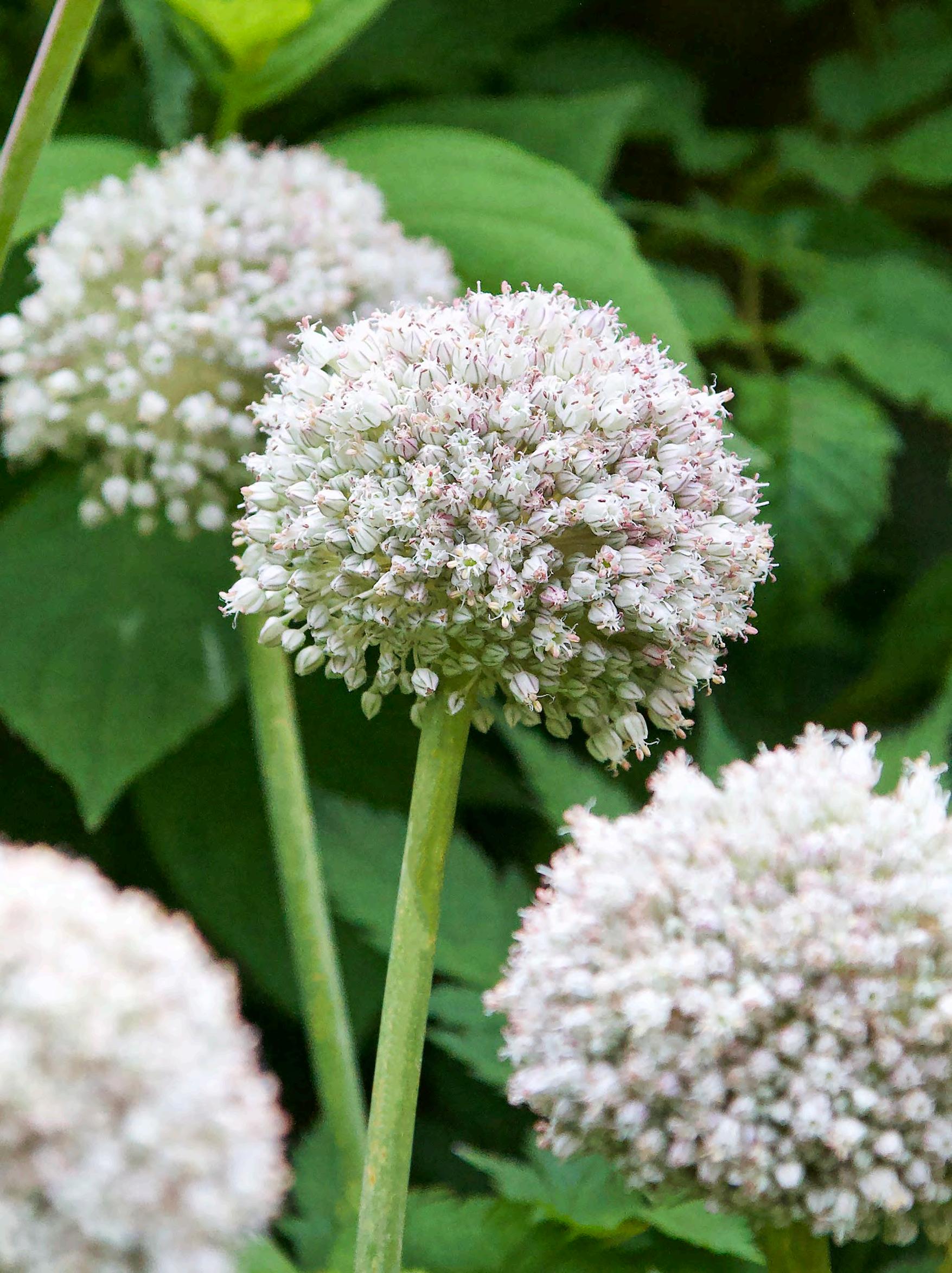
[4] FROM THE GaRdEn importance of public gardens and urban green space
[6] MEET PaT the power of volunteers and donors
[6] OUR TEaM IS GROWInG Welcome new tbg staff members
[8] PROGRaM UPdaTE
new director of learning feels back at home
[10] PRESERVInG BIOdIVERSITY
books in the Weston Family library
[12] RIVERdaLE TOUR save the date for through the g arden g ate 2023 to connect with nature
[14] 30,000 BULBS Hort staff and volunteers help create waves of bloom
[18] TOP 5 TREndS For eco friendly gardening in 2023
[21] CLIMaTE CHanGE
What we do in our gardens can have a significant cooling effect
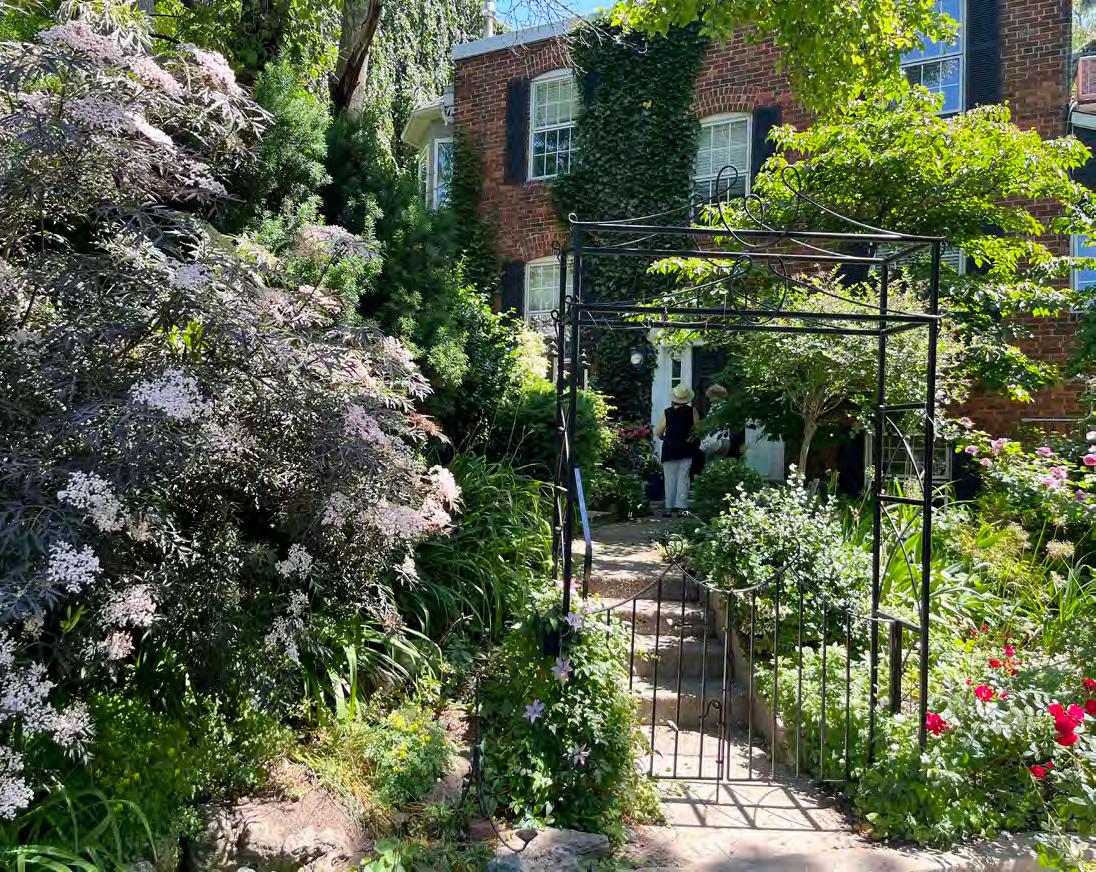
[22] VERTICaL FOREST
skyscraper gardens of the future take root in Milan
[26] JaMaICan GaRdEn lessons from a tropical garden transformation
[30] SOJOURn In SORREnTO on the amalfi coast everything is set in a garden
[36] BOOK SHELF learn the right plants for bird welfare
[38] PUZZLE PIECES botanical artwork makes ideal jigsaws
[ 39] VOLUnTEERS
tbg volunteers deserve our appreciation
[40] HOUSEPLanT PROFILE
slow growing Haworthia a collector’s delight
[41] TEaCHInG GaRdEn a ‘secret’ place for children to connect with nature
[42] GOOd THInGS aRE
HaPPEnInG lots going on at the garden
[44] dIY LaVEndER
CandLES Harness the healing power of your garden
torontobotanicalgarden.ca 3 spring 2023
c o ver: Fritillaria i mperialis ‘ r ubra Maxi M a’; l e F t: a llium ‘W H ite c loud’. pH otos courtesy o F t rade W inds/Joop Huner. s ee page 14. inside Spring 2023 • Vol 52
Through the Garden Gate goes to Riverdale. Page 12
from the Garden
Hig H lig H ting t H e importance of public gardens and urban green space

do not have access to safe and healthy natural places, and that Toronto Botanical Garden provides such a vital resource to our community.
Beyond the gardens and our


As spring emerges all around us with new vigour, I am once again washed in childlike wonder of Mother Nature. Maybe it is the anticipation of 30,000 spring bulbs emerging in the Garden, planted diligently by our horticultural team and volunteers, last fall.
The thought of endless weeks of spring blossoms stirs up the long-held memory of being amongst the daffodils in my mom’s garden, carefully leaping from one stepping stone to another amidst the blossoms…Or the sounds of spring peepers announcing that nature is waking up from a long winter’s slumber…But, if not the blossoms and the sounds, it is certainly the green haze that can be seen at a distance as the trees prepare to leaf out. I love it all, and there is no better place to experience spring than in our city’s parks and public gardens.
For the first time in four years, spring at the TBG includes the return of school children, as we relaunch our youth and family programs. On nearly a daily basis, the botanical garden team gets to experience the pure joy of sharing the wondrous world of plants with another generation. Just wait until summer when our campers return. Through all of these engagements we are reminded that many people in our city
are here on this tiny spot, on planet earth, with a mandate to steward the plants, the ecosystems and the connection of humans to the natural world.
We are fortunate to live in a city that has been named the fourth greenest city in the world by the World Economic Forum. While you may personally know that public gardens and greenspace are vital to your well-being, Toronto Botanical Garden has a key role to play to help our whole community know, experience and embrace the value of our city’s cultivated and natural places.
As we grow, TBG holds the opportunity to magnify the value of the Garden and the programs we offer, so that countless generations experience the good that comes from urban green spaces; and that our public green spaces continue to play an important role in raising social capital across our community, bringing together people from all walks of life to such welcoming places.
Here’s to a bright and abundant future as we embrace being a garden for all.
Stephanie Jutila Executive Director
torontobotanicalgarden.ca 4 Spring 2023 p hoto: a rthur Mola p hotography
Executive Director Stephanie Jutila (centre) with Director of Marketing & Audience Engagement Jenny Rhodenizer (left) and Director of Learning Natalie Harder at the Holiday Market.
FARMERS MARKET FARMERS MARKET


May 11 through Oct 5
Thursdays, 3 to 7 p.m.
WHAT'S ON MARK YOUR CALENDAR
TAFELMUSIK AT TAFELMUSIK AT THE GARDEN THE GARDEN

Sunday, March 26, 2 p.m.
Sunday, April 30, 2 p.m.
TICKETS
Public, $25
Members, $23

Join us in the Garden this spring for fun and engaging programs for the entire family

torontobotanicalgarden.ca/ events
GET THE JUMP ON SPRING GET THE JUMP ON SPRING AND SEEDY SATURDAY AND SEEDY SATURDAY

Saturday, March 25 10 a.m. to 4 p.m.
EARTH DAY EARTH DAY ECO MARKET ECO MARKET
Saturday, April 22 10 a.m. to 4 p.m.
RETURNING! IT'SBACK!
Meet Pat
The power of volunteers and donors in public green spaces
By aleeshia Carman Grant Writer & Development Coordinator

Meet Pat Main, volunteer and donor, dedicating her time to support Toronto Botanical Garden’s mission to create a connection with nature, preserve and showcase beauty and provide the community with life-long learning opportunities.
Throughout her life, Pat has been committed to planting seeds and growing roots in her community. Her volunteering journey didn’t begin at TBG, but we are grateful that it has extended here.
During the pandemic, Pat noticed that her local park’s garden was in disarray and decided to petition her MPP for support. With a small amount of funding and a lot of heart, Pat was able to pull together a team of volunteers to clean up and restore the garden. “Each week new people would approach us asking how they could also get involved. I said, ‘send me your name and email, and I’ll send you a time.’ Our team continues to grow, only slowing down in the winter,” Pat says.
Year-round you’ll find Pat in the Garden Shop and in the warmer months hard-at-work pulling weeds, planting bulbs or tending to different displays and garden beds. Second to her volunteer duties, Pat is now a part of her own micro TBG community, benefiting from the seasonal horticulturists’ knowledge and making friends beyond her weekly gardening shift. “I cannot sing enough praises about the other volunteers that I met and the seasonal horticultuists, who have an abundance of knowledge to share,” says Pat. “They don’t even mind when we make mistakes!”
Volunteers and donors like Pat create a synergy with the Garden, making it a place where people want to spend time. “I love the gardens—I walk them often and even saw a beaver creating its dam last week,” she says.
Our Garden continues to grow because of the investment of volunteers and donors. In fact, Pat takes so much delight in TBG that she encourages her own family and friends to visit. Pat’s connection here is so strong that she showcased her own rock garden during Through the Garden Gate, the annual TBG tour that highlights private gardens throughout Toronto.
Pat’s story is one of many testimonials that demonstrate the power of volunteerism, and the impact one person can make on their community. Volunteers and donors are essential for public green spaces to thrive. As she invested more time in the Garden, a sense of ownership grew, leading Pat to make an even greater investment in TBG. Pat started as a volunteer, later becoming a member and then a donor. “It is important to grow and maintain the spaces where we want to spend time,” she says.
Caring for botanical gardens and urban green spaces can be a lot of work. TBG’s growth is only made possible by the generosity of volunteers and donors.
On behalf of TBG staff, thank you.

our Team is Grow in
Liberté reiLLy
our Team is Grow inG
◗ Liberté reiLLy has joined the team as our new Membership and Database Coordinator. Liberté comes to the TBG from Filoli Historic House and Garden in woodside, California, where she was membership and Development information manager. at Filoli, Liberté helped grow the membership program during the pandemic, supported over 20,000 members and implemented digital membership cards.
Prior to that she held numerous roles at Filoli including external relations assistant, Development assistant and museum interpreter. she interned at the British museum, Horniman museum and Gardens, and Burgh House.
During her undergrad in Vancouver, Liberté worked at the museum of anthropology, science world and roedde House museum. she hopes to bring her membership expertise and passion for gardens to the Toronto Botanical Garden. Hailing originally from California, Liberté is a dual citizen of the us and Canada. Liberté has a Bachelor of arts from the university of British Columbia and a museum studies master’s Degree from university College London in england.
◗ UjaLa bhatia is the new Executive Assistant providing administrative support to executive Director stephanie Jutila. Her position also includes scheduling board and committee meetings and providing Human r esource support.

Prior to Joining TBG, ujala worked in india in the finance and education sectors for more than 15 years assisting organizational leaders. in these roles she supported the Ceo, Cio, and investment team, focused on strategic planning and supporting organizational leaders.

◗ arUna Panday is the new Adult and Family Learning Supervisor. aruna has over 10 years experience developing, leading and facilitating education programs in school and community settings through her work with the scarborough Garden & Horticultural society, as a master Gardener and as chair of the Friends of south asia (Fsa) with the royal ontario museum.
she brings extensive hands-on experience working with plants through her work as a nursery plant supervisor at sheridan nurseries. as both a volunteer herself and someone who manages teams of volunteers, aruna brings with her an intimate knowledge of the importance of volunteers. a runa has degrees in anthropology and ethnomusicology and is currently working on her university Horticulture Diploma.
aruna will be leading our roster of adult education courses, classes and workshops as well as developing engaging family programming for our community. she will be developing educational opportunities to meet the needs of our current community and membership as well as bringing new and unique programs to help us continue to reach new and diverse communities.
TO r O n TOBOTA n ICA lGA r DE n.CA 7 S P r I n G 2023
UjaLa bhatia
arUna Panday
Program UPdate
Not only is she familiar with the TBG but Natalie brings working knowledge gained in the interim at Toronto Region Conservation Authority, Black Creek and High Park Nature Centre and hopes to put some of that experience towards forging partnerships and initiating exciting new TBG programs. Her goal
is to bring the TBG programming content back to where it was before the pandemic and then some. To start with, the Education Department is being relaunched as the Learning Department. “Learning is a more inclusive word,” says Natalie. “Some programs may have an educational component, but we
also support people in their individual learning journeys–such as when people use the Weston Family Library. That’s self-directed learning. Many adult workshops focus on growing new skills such as yoga, fitness and art and are not strictly educational. Learning better reflects what we do.”
Step number one after a tough few years is to “reconnect with the people we do know and revisit some of the programs that are our foundation and then look at adding, changing or adapting so that we don’t lose the most important thing – our people, members, volunteers and community members who take our programs.”
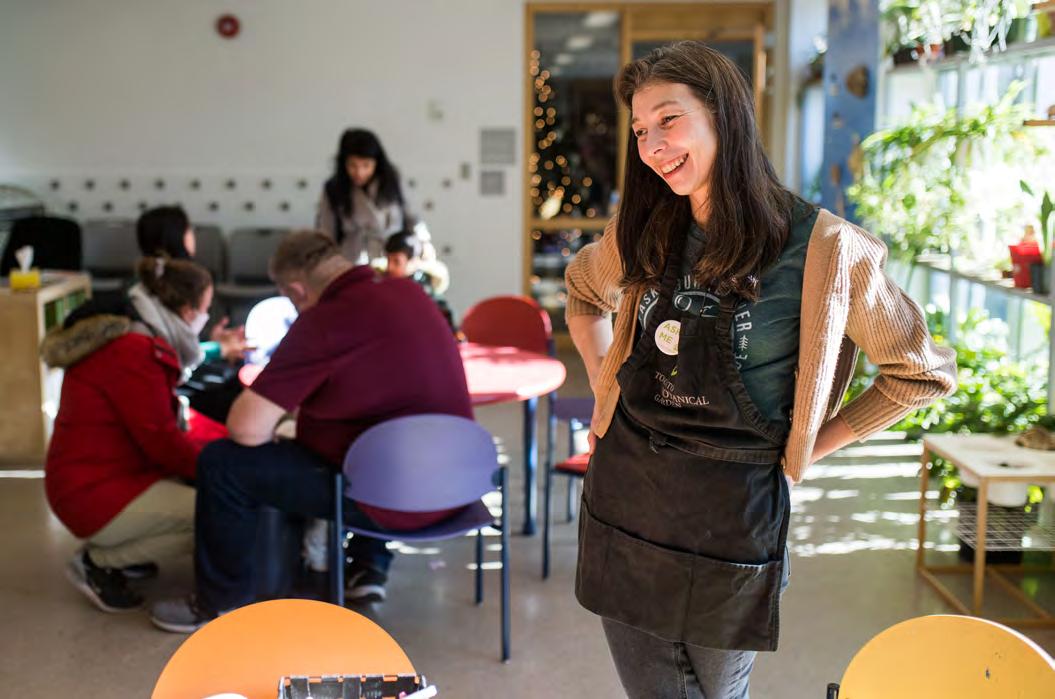
torontobotanicalgarden.ca 8 Spring 2023
News
tBg
tbg’s new director of learning Natalie Harder feels like she’s back home.
LearN
“ I worked at the t BG for seven years (as s uperv I sor/Coord I nator of Ch I ldren’s p ro G rams from 2007 to 2015) and B efore that I was a summer Camp C ounselor here. ”
Floral Design, one of the most popular, well-loved subjects, has made a return and Living Winter, a curriculum-based habitat program for Grade 4 students from priority high-needs schools is also back. This free full-day program includes healthy snacks and a transportation subsidy thanks to a generous donation from the Kinnear Foundation and the Leonard and Gabryela Osin Foundation.
“Teachers were thrilled that we could offer this again,” said Natalie. ”The aim of this program is to remove barriers. The students learn about animals and how they adapt to winter. Then we get them dressed up in winter gear to explore the gardens. It’s wonderful to see a child feed a chickadee from their hand for the first time. We invite them to come back to the Garden anytime. They will ask for maps and how to get here on TTC and often return with friends and family.”
March Break and Summer Kids Camps are also back. So is the popular Ravine Symposium which will take place next fall.
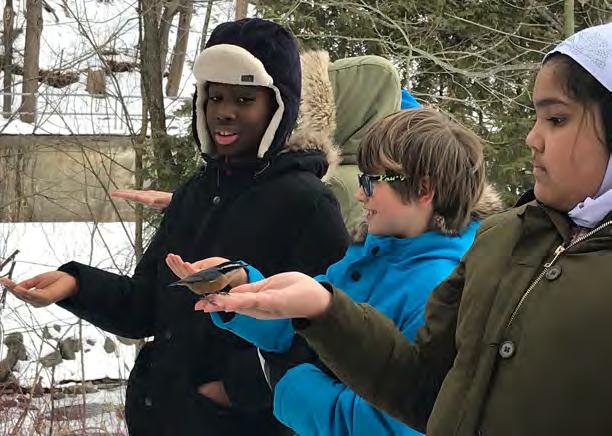

The Authors’ Talks, begun last fall, are continuing and “have given us a way to reach out as more people than just our members have been attending them,” says Natalie.
One of her fondest memories from when she last worked at the TBG was her relationship with the volunteers. “It’s just great seeing them again, some of whom I remember well.”
There will be lots of volunteer opportunities with the Learning Department such as working in the library, as course ambassadors and children and youth program assistants. “Toronto Master Gardeners have offered to help and we will also be looking for a few high school students to help out with kids’ classes in the summer.”
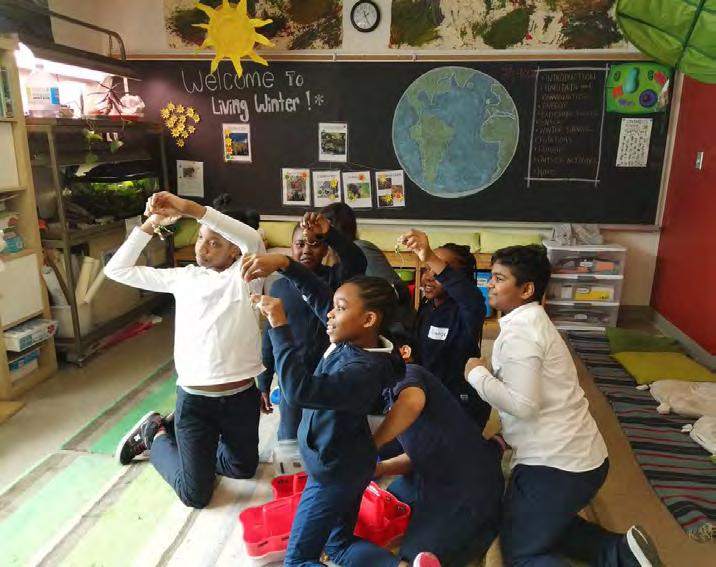
Look for more details on upcoming programs at torontobotanicalgarden.ca/ learning.
By lorraine hunter
torontobotanicalgarden.ca 9 Spring 2023
“the aim of this program is to remove barriers. the students learn about animals and how they adapt to winter. then we get them dressed up in winter gear to explore the gardens. it’s wonderful to see a child feed a chickadee from their hand for the first time.”
Preserving Biodiversity
Books in the Weston Family Library
By Lee robbins
Environment ministers from around the world gathered in Montreal in December 2022 aimed at preserving the planet’s biodiversity. Talks at COP15 temporarily hit a roadblock when more than 60 nations from the global south walked out over concerns that pledges from rich countries to fund conservation were too small and too vague.
Climate change and our planet’s troubled biodiversity are regular headlines in the news and the stories coming from COP15 and other places sometimes make me feel powerless about what to do about climate change and how to help the planet. At a time when understanding our connection to the physical environment is becoming increasingly important, Ontario author and educator Zach Loeks’ recent book The Edible Ecosystem Solution: Growing Biodiversity in Your Backyard and Beyond (call number: S494.5.P47 Loe 2021) is a very welcome addition. Loeks provides a road map and adds tools to our collective efforts, offers insights on how to restore our environment and demonstrates practical solutions and opportunities that we can use.
Loeks is an educator, designer and grower who specializes in edible ecosystem design through landscaping and education. He is passionate about how small actions, strategically linked, can make big changes: areas as small as 2.4 square metres / 25 square feet (1.52 x 1.52 metres /5 by 5 feet) can be transformed into diverse, delicious and beautifully abundant spaces with an edible-ecosystem design. Loeks has examples of underutilized or inefficient greenspaces in our own communities that could be transformed into sustainable and self-sufficient spaces given a little effort, with examples throughout the book in places like Ottawa, Guelph, North Bay and beyond.
His inspiring but practical vision provides the tools, principles and concepts of edible landscape design and for growing our own plants for consumption.

I also love Loek’s very artful water colour illustrations adorning almost every page, enhancing the look and feel of the book and the understanding of his text.
The theme of working with and enhancing the natural ecology of home gardens is picked up in Kelly D. Norris’ gorgeous and inspiring book New Naturalism: Designing

“ If you have a garden and a library, you have everything you need.”
toronto B otanica Lgarden.ca 10 Spring 2023
marcus tullius cicero (106 Bc – 43 Bc)
and Planting A Resilient, Ecologically Vibrant Home Garden (call number: SB 439.Nor 2021). Norris is an award-winning author, photographer, public speaker and plantsman, and the former director of horticulture and education at the Greater Des Moines Botanical Garden, a revitalized public garden in Des Moines, Iowa.
He is a passionate advocate for biodiverse gardens that use every square foot to its maximum potential by curating plants to suit their natural environment and their potential to enhance the beauty and aesthetic value of the landscape. Kelly’s ideas are somewhat complex: detailed without getting too technical. He goes into gardening for different light conditions, soil types, zones and how to design everything to achieve the desired effect.
Beautiful photographs complement the text and showcase Norris’ ideas: a framework for how to approach gardening with an ecological mindset and inspire the reader to create their own naturalistic garden.
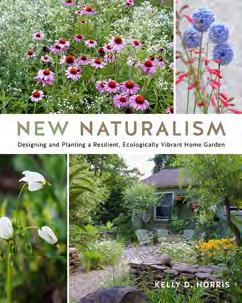
Kelly Norris teaches an online six-week course in ecological landscape theory, design and management for gardeners based on his book: https://www.kellydnorris.com/course

Both of these books challenge us to change our way of thinking around our green spaces and what we can do in our own backyards to take an active part in addressing the issues of climate change and pollinator and species decline.
Lee Robbins is a Weston Family Library volunteer with a passion for libraries, gardens and gardening.
garden obelisks Make use of vertical space in your garden with a 4 or 6-foot obelisk. Made in toronto exclusively for the toronto Botanical garden, these obelisks are superb structures for showcasing and supporting vines and vegetables. Black, powdercoated steel ensures that these towers remain rustresistant and durable for many years to come.

Available throughout the year at the garden shop.

Available in two sizes: 4 ft $99.99; 6 ft $124.99.
gArden toUrs - by Hna travels – your garden tour specialist.
neWport ri Flower Show – June 20-24, 2023; BUFFaLo garden FeStiVaL toUr – July 23-25, 2023; also, Hna is offering a Louise penny tHree pineS toUr – June 4-7, 2023.
all tours led by Margaret dailey-plouffe. email Margaret at hnatravels@gmail.com or call 613 843-9900.

Sales Representative, ABR, SRES H AL L O F FAME AWAR D LI FE TI ME ACHI E VEMEN T AWAR D TOR ON TO M ASTER GA RD ENE R RE/MAX HALLMARK REALTY LTD., BROKERAGE Direct 416.564.9450 @JoseeCoutureTorontoRealEstate
• classified •
riverdale
Save the date for tbg’s through the garden gate tour 2023
By Veronica Sliva
Last year’s Through The garden gaTe 2022 held in the Wychwood area of Toronto was a huge success, one of the best ever. We’re going to do it again in 2023! This year’s tour of beautiful private gardens will take place in the east-end Toronto neighbourhood of Riverdale. Be sure to mark your calendar for the weekend of Saturday and Sunday, June 10 and 11, 11 a.m. to 4 p.m. Riverdale is a high-density urban neighbourhood known for its diverse community, abundant dining choices, quaint Victorian homes and some pretty amazing gardeners.
Garden visitors can visit more than 15 residential gardens, of varying sizes and themes. Because of the tour’s self-guided format, you can discover each garden at your own pace with a map and a guide that describes the features of each garden. To be sure, there is something new to discover and inspire behind every garden gate.
A complimentary shuttle bus service allows you to “hop on and hop off” along the route, although the route is very
“walkable” for those who like to move on foot.
Back by popular demand, there will be live music in one or more of the gardens.
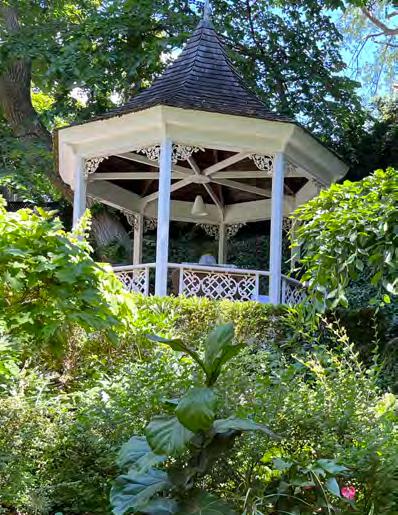
Knowledgeable Toronto Master Gardeners will be in each garden, ready to answer any of your plant or garden design questions.
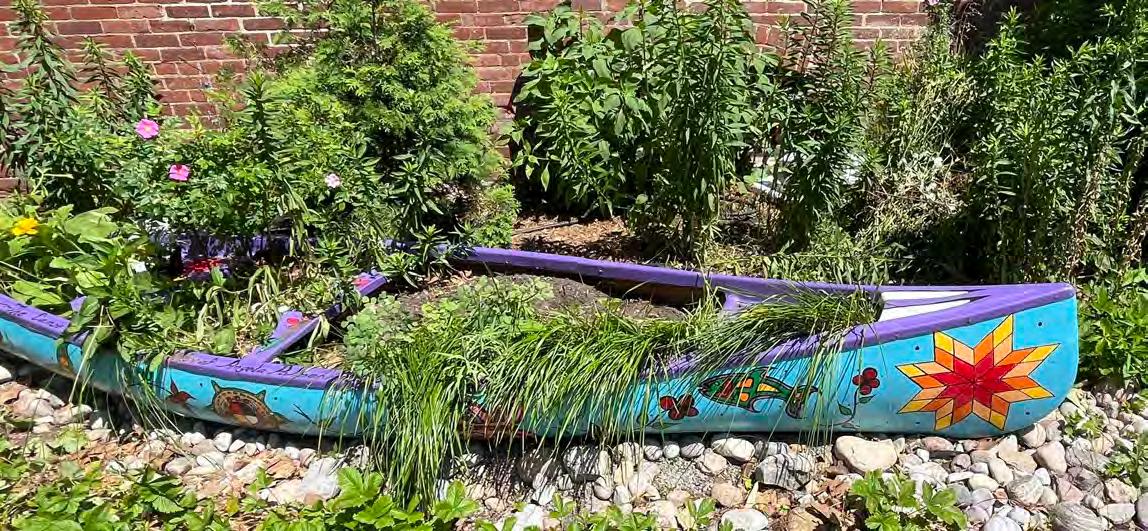
The Riverdale area features an abundance of parkland making it a welcome escape from the hustle and bustle of big-city living. Riverdale Park is one of the largest green spaces in the city. With its steep hill view of the city it is a favourite location for sunset picnics.
Withrow Park is a central hub and meeting place and the site of a popular Saturday farmers’ market.
Come early to visit Withrow Farmers Market on Saturday or linger after the tour to shop or dine at one of the local restaurants in the Danforth Village.
• Advance tickets will be available online in the spring of 2023 https://torontobotanicalgarden.ca/enjoy/ special-events/through-the-garden-gate/
torontobotanicalgarden.ca 12 Spring 2023
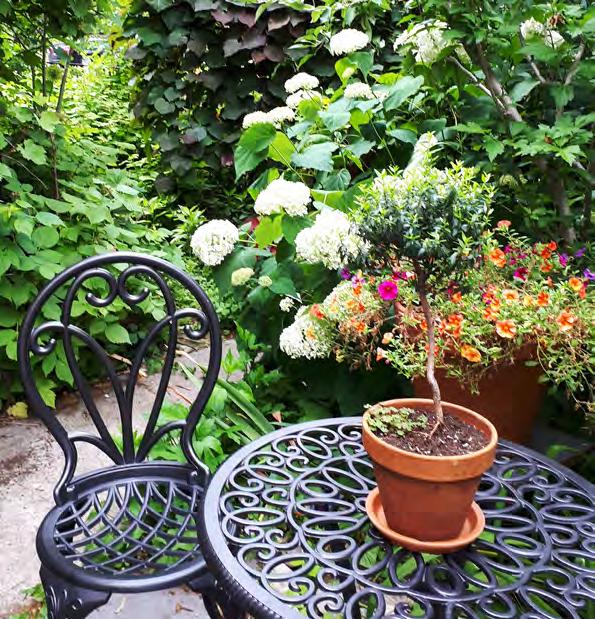
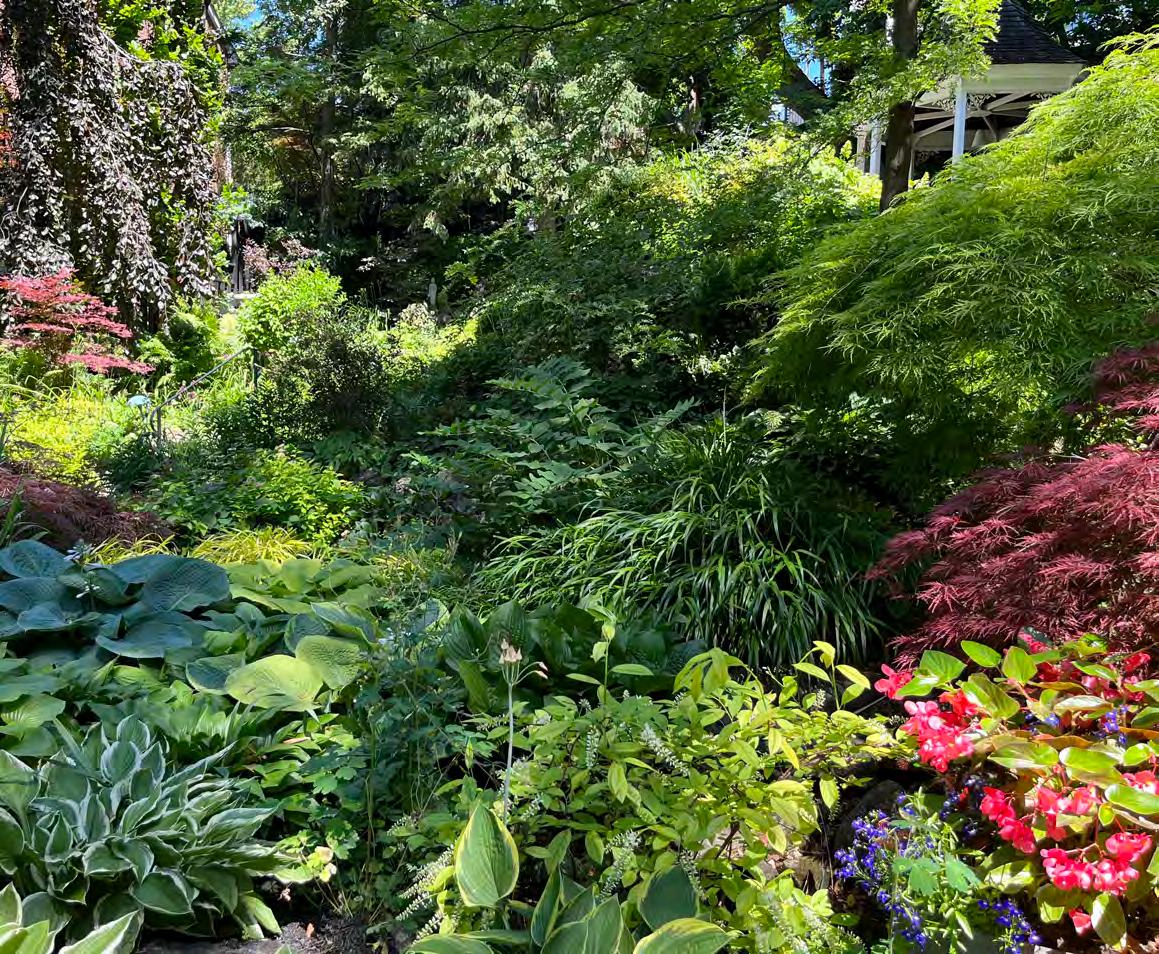
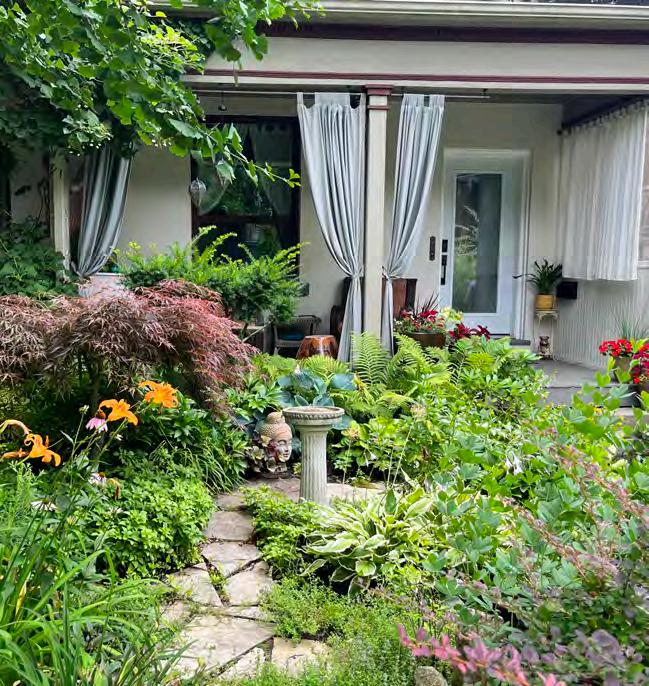
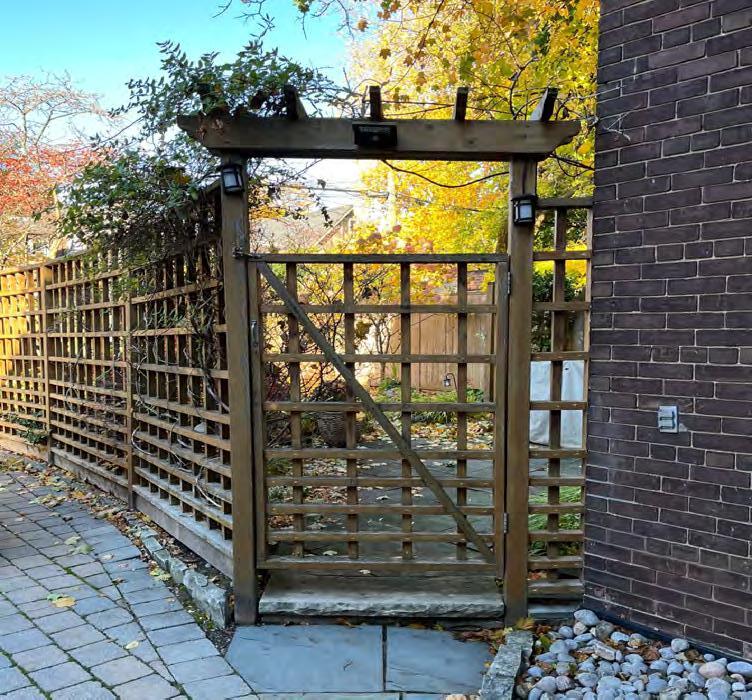
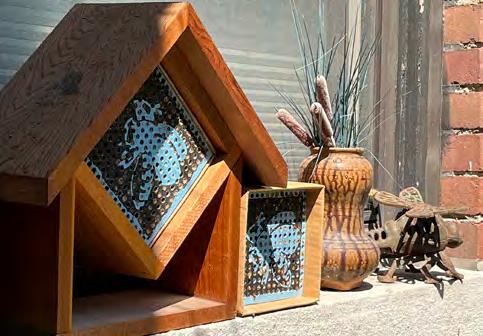
Eye-Catcher ‘Have Pleasant Dreams’

30,000 BulBs
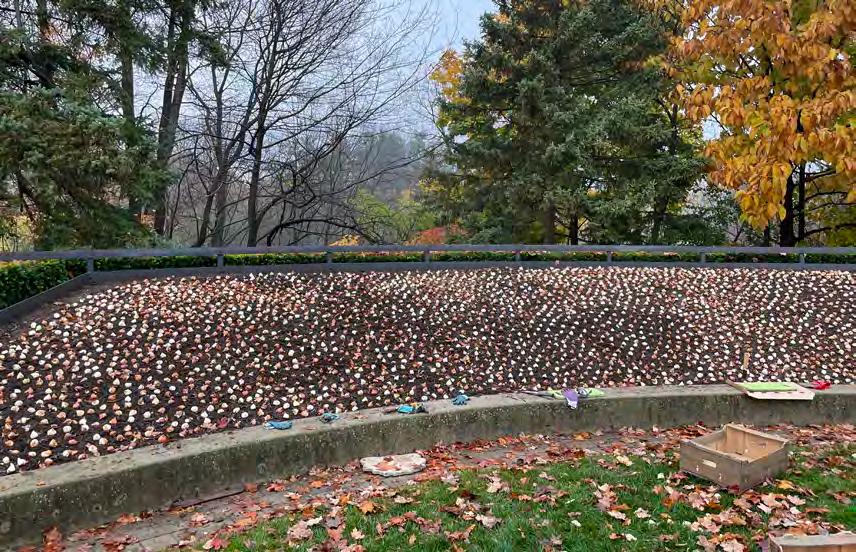 By
Burkholder
By
Burkholder
Supported by an army of volunteers, TBG’s horticultural team planted more than 30,000 bulbs last autumn. Some species will start to bloom in March, with a full blast of colour around the gardens in April and May.
As someone who was proud to plant 100 bulbs in her front garden in October, I cannot even imagine planting 1,000 bulbs let alone 30,000! It made me think about what is involved in managing such a project. What is the planting strategy? What types of bulbs? How many people were involved? And where did these bulbs come from?
Horticultural Director Roger Gettig and his team began bulb planning in spring 2022. They looked at how to maximize the blooming experience in the annual beds for April and May with the goal of removing them for the summer annual displays planted at the beginning of June. Various perennial bulbs were added throughout the gardens.
Why so many bulbs?
Planting large numbers of perennial bulbs densely will help create waves of blooms, maximizing their visual impact for viewers. Diverse types, sizes and colours were selected to add interest as well, and perennial bulbs were planted with room to expand in the future. About 3,300 Narcissus bulbs and over 13,000 Tulip bulbs were planted.
Display a reas
Bulbs were planted in key beds at various entrances to the TBG, in beds throughout the gardens and on the north side of the building facing Lawrence Avenue. Some examples of the types of new bulbs installed include:
• TBG Entrance (traffic circle): ‘Have Pleasant Dreams’ bulb mix. An apricot, pink and purple blend of tulips, hyacinths and grape hyacinths. Daffodil ‘Topolino’ was also added. Short blooms were used so as not to block the Toronto Botanical Garden sign on the stone wall.
• Arrival Courtyard: ‘Fireworks’ mix. Orange lilyflowered tulip ‘Ballerina’ complimented by the yellow daffodil ‘Tahiti’ that has flashes of orange in the petals.
• Arrival Courtyard, Mary Fisher bed (under wisteria): Italian arum, ‘Exotic Emperor’ Fosteriana tulip
• West end of Arrival Courtyard, west side (under the Amur maackia): purple muscari ‘Bling Bling’
• Garden Hall bed (under Parrotia, Persian ironwood): lavender blue camassia, with star-like flowers, blue and white squill, fritillaria with tall ivory bell-shaped flowers
• North side of building (under silver maple) ‘Toronto’ variety of Greigii tulip.
• Milne House Garden Club bed: more fritillaria, striped squill, scilla and daffodils
Photos Courtesy of t radewinds/Joo P h uner
no, that is not a typo. hort staff and volunteers help create waves of bloom
Leanne
torontobotani C algarden.C a 15 sP ring 2023
Former carpet beds were planted with ‘Daily News’ bulb mix last fall.
• Wisteria pergola: Darwin tulips ‘Oxford’ in red and ‘Daydream’ in yellow turning apricot
• Pollinator beds: Sicilian honey-garlic bulbs, with drooping purple-yellow flowers

Finally, in the former carpet beds, the ‘Daily News’ bulb mix was planted, a triumph tulip blend of pale pinks, deep purple, and red.
a nti-Critter s tr ategy
In the Arrival Courtyard beds you can clearly see protections used to prevent squirrels and other critters from dining on the bulbs. The planting team installed 16-gauge black PVC-coated poultry netting to thwart digging and removal. Bulb selection also played a role to deter animals from digging up bulbs. Starflower bulbs smell like garlic. Of course, allium, daffodil and Sicilian honey garlic bulbs are also unappealing to creatures.
t he p lanting t eam
Some 40 to 50 volunteers helped the horticultural team with the planting which took place from October to November. Executive Director Stephanie Jutila also pitched in one day!
“We had all the volunteers help on all their normally scheduled days during a week in October,” said Roger. “Then we continued planting until the very last day of the volunteer season, so some had several bulb planting sessions over the course of a few weeks. We kept getting more bulb donations after our initial purchase. I do not know how we could have done it without them. I would still be planting today if it were not for them.”
The Toronto Botanical Garden thanks the following donors for their generous contributions:
• The Greater Toronto Bulb Society and Milne House Garden Club funded the bulbs for the carpet beds. Michael Erdman of the Greater Toronto Bulb Society also donated hundreds of Darwin tulips that will bloom during a period in April when not many tulips bloom.

• “The Greater Toronto Bulb Society and Milne House Garden Club were very happy to raise about $2,500 for spring bulb planting at the TBG this past October, accounting for about a third of their bulb budget,” said Michael. Not only did this help fund the large and beautiful display beds at the entrance to the Gardens, but it also allowed Roger and his crew to begin planting in areas of the site that have laid fallow for several years; in other words, to bring them ‘back to life’ with interesting plants. We are looking forward to continuing our support as the TBG expands into the valley.”
• Tradewinds International (Caroline de Vries) provided a significant quantity and variety of bulbs and expertisein addition to bulbs already purchased by the TBG. The bulb mixes were sourced through Tradewinds.
torontobotani C algarden.C a 16 sP ring 2023
Crocus species ‘Ard Schenk’
Camassia Caerulea

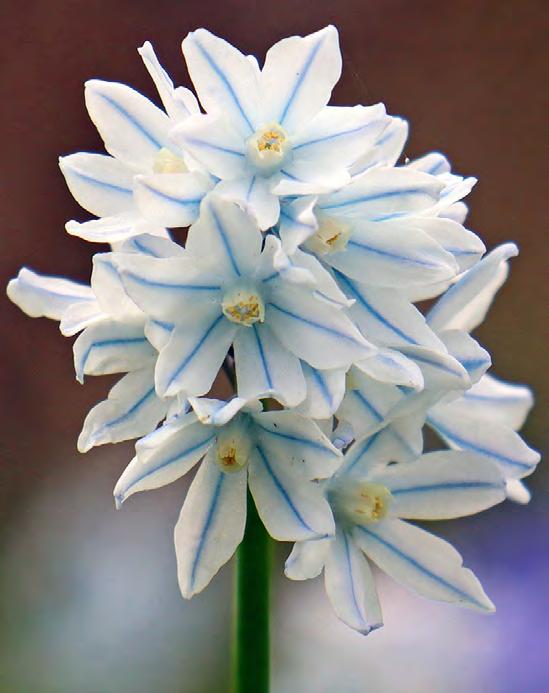
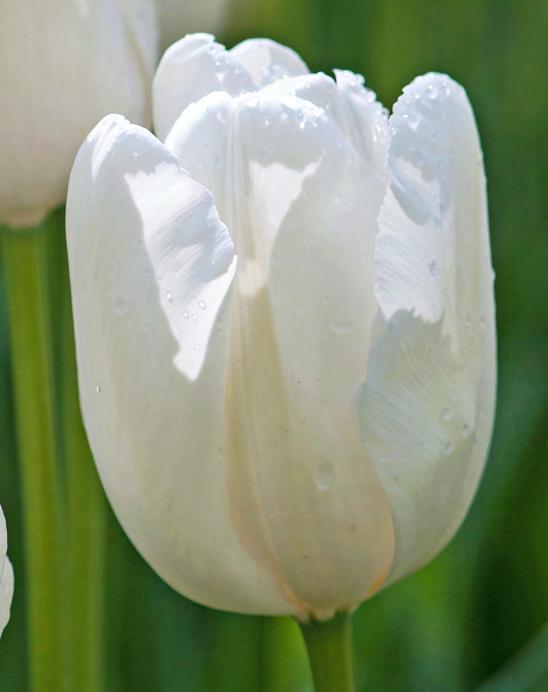
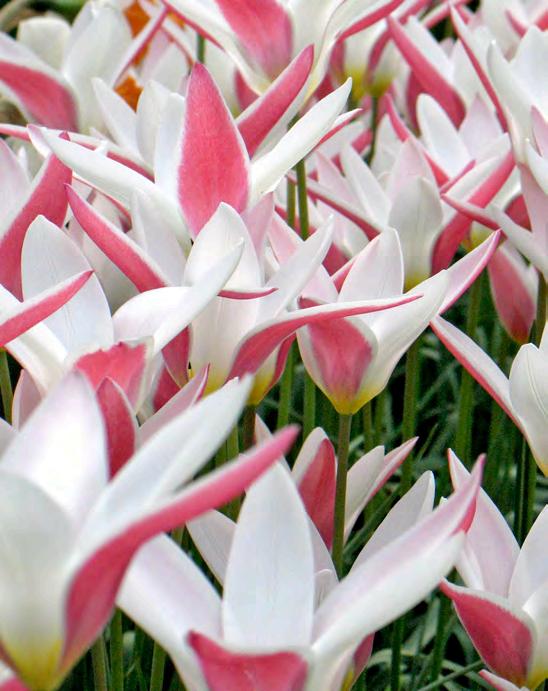
torontobotani C algarden.C a 17 sP ring 2023
Narcissus ‘Tahiti’
Striped Squill
Darwin Hybrid Tulip ‘Hakuun’
Peppermint
Stick Tulip
Top 5 Trends
For eco Friendly GARdeninG in 2023
By Veronica Sliva
After sifting through the many so-called trends that have surfaced, here are the Trellis top five gardening trends for 2023 plus some relevant websites and book suggestions from the TBG Weston Family Library.
1. Techniques To AdjusT To c lim AT e c h A nge
It can’t be denied, we are experiencing more and more extreme weather conditions (too hot, too cold, too wet, too dry, high winds?). changing climate patterns have many gardeners scratching their heads these days. as gardeners, we can no longer predict what the seasons will bring. the rHS predicts, “Following the heat and drought of summer, gardeners will be looking for ways to future-proof their spaces for a more extreme climate”. though these remarks refer to british gardeners, fickle weather patterns are affecting us, too. See carol gardner’s article on climate change on page 21.
Water-Wise Gardening the trend towards water-wise or xeriscape gardening is not new, but perhaps the technique is becoming more mainstream. creating gardens that minimize future watering is a continuing trend. gravel gardens are now a thing.
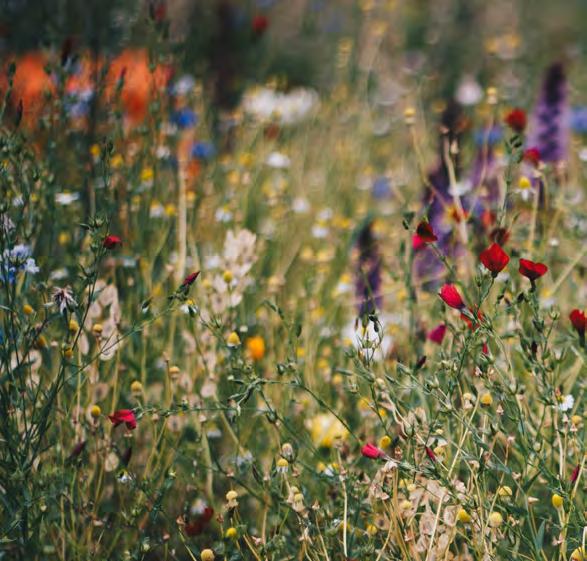

Gravel Gardens the late english plantswoman, beth chatto (1923 – 2018) created her world-famous gravel garden in 1991 on what was a parking lot. this climateresilient garden receives no supplemental watering other than what nature provides and still it more than thrives. people from all over the world flock to see this beautiful garden. We can learn a lesson here. check out tbg’s Weston Family library to borrow her book: Beth Chatto’s Gravel Garden: Drought-Resistant Planting
At the beginning of every year, organizations like the Garden Media Group (a research company that identifies global consumer trends) https://www.gardenmediagroup.com/ trends, the Royal Horticultural Society (RHS) https://www. rhs.org.uk/ and others, report on what trends are up-andcoming in gardening, landscape design and green living.
Through the Year https://library.torontobotanicalgarden.ca/ cgi-bin/koha/opac-detail.pl?biblionumber=16466
Or try a google search online to reveal dozens of sites with how-to information.
Rain Gardens What is a rain garden you ask? a rain garden is a landscaped feature planted with species that tolerate sudden wet conditions followed by drier
torontobotanicalgarden.ca 18 Spring 2023
Gravel gardens are now a thing.
conditions. rain gardens minimize the effects of heavy rainfall. the concept is based on creating a shallow depression in the ground that is amended with loose, deep soil. rain and melted snow (stormwater) run off the grass, roof and driveway collecting in the depression where it is absorbed in the soil, thus preventing the runoff from entering the storm drain system and eventually our waterways. Many combinations of flowers, shrubs, grasses or ferns do well in a rain garden. native plants are best because they are well suited to local growing conditions, and support local wildlife including birds and butterflies. to find out what plants will work for you, check out the toronto and region conservation authority’s website for A Complete Guide to Building and Maintaining a Rain Garden, https://trca.ca/news/complete-guidebuilding-maintaining-rain-garden/.
You can also borrow Greening your grounds: a homeowner’s guide to stormwater landscaping projects, from tbg’s Weston Family library https://library. torontobotanicalgarden.ca/cgi-bin/koha/opac-detail.pl ?biblionumber=52604
2. e ncour Aging m ore Wildlife
THe continued interest in bringing pollinators (birds, bees and butterflies) and other creatures to our gardens is fueling gardeners to think about creating wildlife-friendly ecosystems in their yards. the trend indicates we are becoming more focused on educating ourselves about native plants that contribute positively to local conditions. check out the canadian Wildlife Federation’s informative (and free) Youtube webinar g ardening with Wildlife in Mind https://cwf-fcf.org/en/explore/ gardening-for-wildlife/?gclid=CjwKCAiA8OmdBhAgEi wAShr4078EIBhIym9jlp0endNw-gMrlEO8mDEhVq F5JPSXFr2dRPUpAP-4PBoCq1EQAvD_BwE.

3. g e T r id of T he lAW n…bu T T hen W h AT ?
For YearS, forward-thinking gardeners have been removing or reducing the amount of turf in their yards. lawns are monocultures that guzzle water (a precious resource) and are not particularly pollinatorfriendly. the answer has been to replace lawns with borders or mixed plantings of annuals, perennials, shrubs and trees. but not everyone wants to replace their lawn with a border. the solution of a ‘mini-meadow’ is gaining popularity. the idea is to grow easy, low-lying plants that intertwine with grasses and flowering plants that support pollinators.
More seed companies are offering seed mixes as an alternative to a lawn. consider West coast Seeds’ alternative lawn Mix Wildflower Seeds at https://www.westcoastseeds.com/products/alternativelawn-wildflower-mix#full-description-anchor. containing 13 species of plants that bloom every year, the mix forms a low-growing, dense groundcover composed of fescues, flowers and clover species that provide a colourful and less demanding alternative to traditional grass lawns.
an online search reveals a variety of resources to guide you. or, you can check out the book Mini Meadows: Grow a Little Patch of Colorful Flowers Anywhere around Your Yard by Mike lizotte https:// www.amazon.ca/Mini-Meadows-Colorful-FlowersAnywhere/dp/1612128351.

pH oto S : p exel S torontobotanicalgarden.ca 19 Spring 2023
Mini-meadows are a trending way to replace lawns.
Planting native plants will attract pollinators to your garden.
alternatively, if you must have a lawn, consider growing an eco-lawn. developed in the 1990s by Wildflower Farm, eco-lawn is a blend of five types of fescue grass that work together to form a slow-growing, drought-tolerant turf. because it is slow growing, it requires less fertilizer and less watering due to its deep root system. eco-lawn can be left un-mowed for a freeflowing carpet-like effect. https://www.wildflowerfarm. com/eco-lawn.html
4. s ensory gA rdening – h o W d o your Pl A n T s mA ke you f eel?
GardenS create a place of calm and make us feel good. the desire to create gardens that stir all the senses will be a big trend in the future. Fragrant plants and those with interesting textures will figure strongly in garden design. For example, garden designers often suggest planting rosemary and lavender near seating areas. plants with leaves that have texture such as the soft, velvety foliage of lamb’s ear (Stachys byzantina) add a different sensory dimension to the garden. gardens that encourage wellness are those that are meditative and help quiet the mind. a good resource is The Well-Gardened Mind: the restorative power of nature by Sue Stuart-Smith. it is available for borrowing in the Weston Family library and was reviewed by rose roberts in the Spring 2022 issue of trellis.
5. h ouse P l A n T s
THe HouSeplant craze of the late 60s and 70s is back but it is updated. in the 70s common houseplants like the spider plant (Chlorophytum comosum) had their moment (along with macrame hangers). it is still a great houseplant, but nowadays the trend is more toward the rare and exotic. retailers of every kind from the neighbourhood grocer to the big box stores are fueling the craze by offering not only the triedand-true well-known varieties but many new and interesting exotics (some with hefty price tags to match).
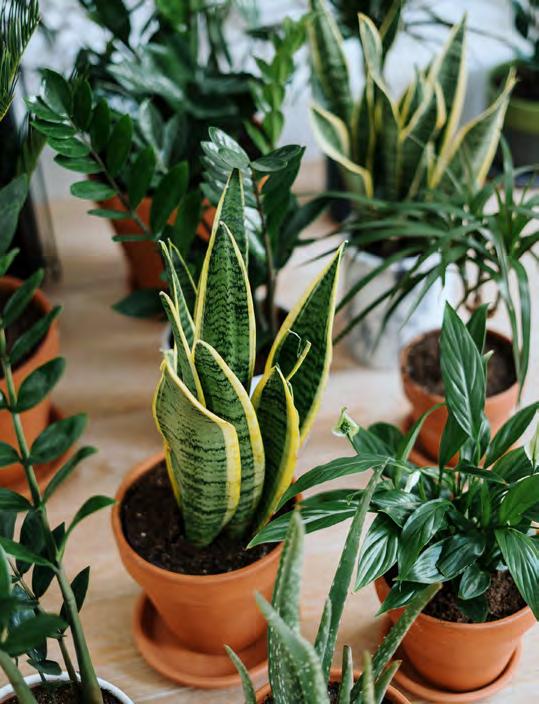
Notes: See reviews of two books on preserving biodiversity by library volunteer lee robbins on page 10 See Houseplant profile by georgie Kennedy on page 40. Well-known plant breeder p roven Winners® recently partnered with the p lant company (a leading source of unique houseplants in n orth a merica) to market the leafjoy™ collection, a series of new houseplant varieties under the p roven Winners brand. to help you choose the plants most appropriate for your environment, the plants are categorized as follows:
Atrium Collection: High-light plants for brightly lit spaces. Cocoon Collection: low-light plants for interior rooms. Worklife Collection: Space-saving plants for desks and tabletops.
SpaScene Collection: Humidity-loving plants great for bathrooms. You can see the collections here https://www.provenwinners.com/leafjoy.
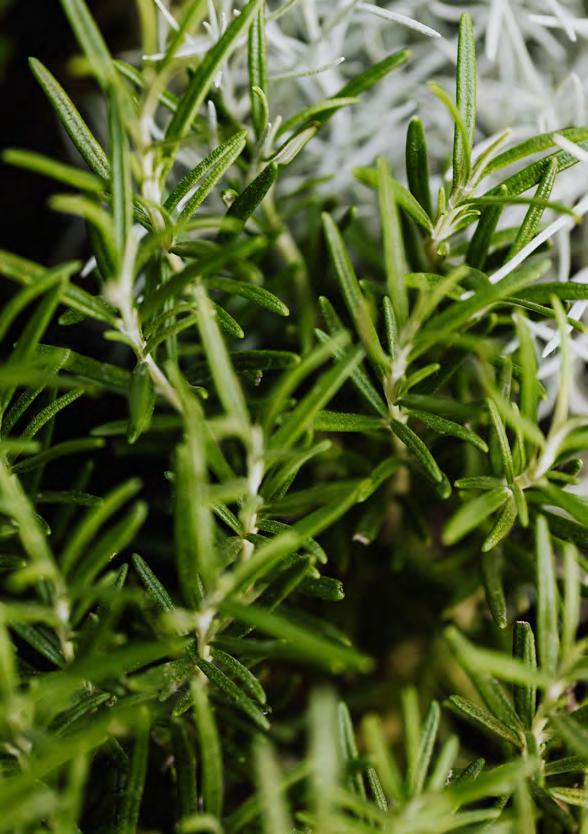 Fragrant plants like rosemary (pictured) or lavender are often planted near seating areas.
Fragrant plants like rosemary (pictured) or lavender are often planted near seating areas.
climAte chAnge
“Heat getting to you?” he inquired.
“i nodded and replied, “What’s your secret? it doesn’t seem to be bothering you at all?”
“i’m from Texas. it’s like this all the time,” he said.
That told me two things:
1) i don’t want to go to Texas and
2) the human body can apparently adapt. But what about our plants?
We hear so much about climate change that our minds are blizzards of information, but really, it comes down to this: the emission of greenhouse gases (such as methane and carbon) from transportation, electricity production, industry and some agricultural activities prevents the earth’s heat from escaping, causing global warming. Governments are, of course, trying to counteract that, but, to date, it isn’t going all that well anywhere. That’s where we gardeners can do our bit to come to the rescue (imagine inspiring music), because what we do in our own home gardens can have a significant cooling effect.
For example, just by using groundcovers in empty places in our plant gardens and cover crops in our vegetable gardens, we can help to keep the carbon in the soil, and the soil cooler and more resilient.
By Carol Gardner
in the midst of a frigid Toronto winter, it’s hard to relate to climate change. However, after a trip to the south of France this past summer, i get it. The temperature was the hottest on record for France and most of europe, averaging about 39.1 °c (102.38 °f) and it was absolutely debilitating. While languidly leaning on a wall, waiting for my husband to pay for pastries (well, you still have to eat, eh?) i encountered a young man who looked cool and energetic.
Happily, we don’t have to start from scratch, because many of us have already begun to change our garden habits by using organic rather than chemical fertilizers, using natural pesticides and cutting back on lawns. Here are some other suggestions to help us to be a part of positive change:
• Add compost and aged mulch to your soil to retain moisture and keep your plants relatively cool.
• Avoid peat moss, which breaks down quickly and squeezes the air out of the soil. Moreover, the harvesting of peat moss releases large amounts of
carbon dioxide which adds to greenhouse gas levels.
• If you have a wet spot in your garden, consider installing a rain garden or above-ground beds as protection from pooling rainwater.
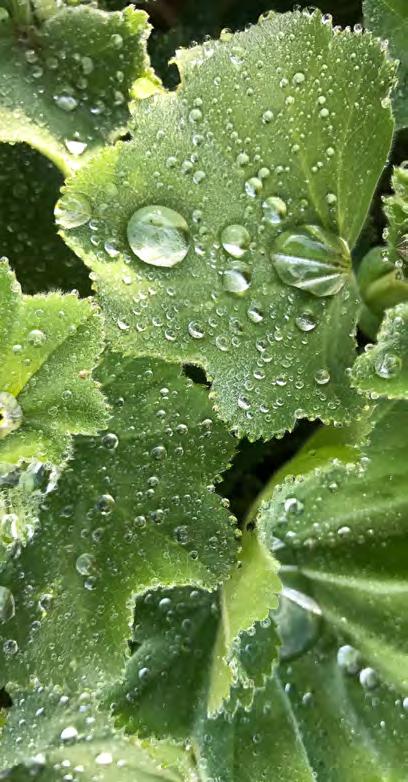
• Select your plants carefully for the location and conditions.
• Plant diversity helps reduce stress and disease, so mix up your edibles, herbs and perennials in the same beds.
• Use native plants to sustain native birds and insects.
• Look for plants that are drought tolerant and disease resistant and, of course, non-invasive.
• With their long roots, perennials are much more sustainable than annuals and they help keep carbon in the ground.
• If possible, construct wind barriers to protect plants from high winds and storms.
• Plant shade trees and use rain barrels to collect rain water for watering plants.
The Toronto Master Gardeners have a very comprehensive list of recommended plants for climate change (drought tolerant Perennials: A toronto master gardeners guide – toronto master gardeners and the ontario government has a tree atlas by region that should help you decide what trees to plant the tree Atlas: south central region | ontario.ca
Obviously, we can’t prepare for everything that may happen in the future, but, if we take one step at a time, the new regime will quickly become second nature. As environmental journalist and professor Michael Pollan says “The single greatest lesson the garden teaches is that our relationship to the planet need not be zero-sum, and that as long as the sun still shines and people still can plan and plant, think and do, we can, if we bother to try, find ways to provide for ourselves without diminishing the world. ”
torontobotanicalgarden.ca 21 Spring 2023 pH oto: u n S pla SH
What we do in our own garden can have a significant cooling effect
Alchemilla mollis (Lady’s Mantle) is a drought tolerant, disease resistant perennial.
Skyscraper gardens of the future take root in Milan
 By Lorraine Hunter
By Lorraine Hunter
Vertical Forest
torontobotanicalgarden.ca 22 Spring 2023
[Inspirational
]
Gardens
Driving around on a bus tour of Milan, Italy last fall, I was amazed at all the balcony gardens on apartment blocks that we passed. Suddenly, a building that can only be described as a vertical forest appeared. It turned out there were two such towers each covered with trees, shrubs and other plants forming a kind of “green curtain” over each edifice.
Although not officially on our tour, the Bosco Verticale (Vertical Forest in English), I discovered through subsequent research, is the prototype for a new form of architectural biodiversity that focuses not only on people but also on the relationships between humans and other living species.
Designed by Stefano Boeri, the Vertical Forest is a model for a sustainable residential building, contributing to urban biodiversity without expanding land use.
The two Milan towers, completed in 2014, are 80 and 112 metres high, housing some 800 trees, 15,000 perennials and/or ground covering plants and 5,000 shrubs. The

buildings house an amount of vegetation equal to about 30,000 square metres of woodland and undergrowth consolidated on 3,000 square metres of urban surface, Thus, the Vertical Forest helps limit the sprawl of cities pushing for more greenery.


The “green curtain” regulates humidity, produces oxygen and absorbs CO2 and microparticles, thus contributing to the reduction of both heat loss and air pollution. This combination has brought the project a number of awards, including the International Highrise Award in Frankfort (2014) and the award for the Best Tall Building in the World from the Council for Tall Buildings and Urban Habitat at Chicago’s Institute of Technology (2015). The complex is also gold LEED (Leaders in Energy and Environmental Design) certified.
This new model of urbanization has large, staggered, overhanging balconies designed to accommodate large external tubs for vegetation and to allow the growth of larger trees, some growing to heights of up to three floors. The containers are protected with waterproof membranes and sheeting. Each has an automatic irrigation system.
torontobotanicalgarden.ca torontobotanicalgarde n.ca
the two Milan towers house some 800 trees, 15,000 perennials and/or groundcovers and 5,000 shrubs equal to about 30,000 square metres of woodland on 3,000 square metres of urban surface.
View from one balcony looking down.
Plants were chosen following three years of study by a group of botanists and ethologists, and were pre-grown in a nursery with similar conditions to those on the balconies. As well as evergreen species, deciduous specimens include beeches, yellow acacias, oaks, ash trees, maples, fern and ivy.
Variations in plant colour, shape and texture produce an iridescent view in every season. The main inorganic growth medium is volcanic lapilli (small stones or grains) mixed with green compost and topsoil.
The plants are maintained by a team of arborists/climbers known as the Flying Gardeners. Using mountaineering techniques, they descend from the roof of each building once a year to prune and look after the plants.
In the few years since its construction, the Vertical Forest has been colonized by numerous animal species including some 1,600 specimens of birds and butterflies.
Conceived as a prototype of the skyscrapers of the future, vertical forests have been or are being designed by Boeri and others in such places as the Netherlands, China, Albania and France.


A plan to build a vertical forest in Toronto was proposed in 2018.
To see a video of the Flying Gardeners at work click here: https://we.tl/t-tPJ4mdrPKp
p hoto S : b oeri Studio, g iovanni n ardi, Michael h ierner, d i M itar h aryer
Jamaican Garden

lessons learned from a tropical garden transformation
By Georgie Kennedy
Let me introduce you to our tropicaL garden. Somewhere on the highway between Montego Bay and Ocho Rios, we veer off to an inconspicuous road that leads directly to the open sea. Just before reaching the end, we stop to photograph a display of massive pale blue and green agaves and the gate opens.
torontobotanicalgarden.ca 26 Spring 2023 p hoto S : g
eorgie Kennedy
The croton-lined driveway meanders beneath a canopy of Silver Bismarck and Royal palms to a house partially hidden by Chinese fan and areca palms. We walk through to the terrace and down a cut-stone pathway, brushing past hibiscus and bougainvillea, sea lettuce and cycads, to a white sand beach cove nestled in the turquoise shelter of Discovery Bay. Let’s go for a swim.
Fact: Despite the name, Columbus did not actually land here on his voyages; his ships could not sail over the coral. He named it Puerto Seco (Dry Harbour) because of the lack of rivers and scarcity of rain.
the transFormation
My parents-in-law purchased this one-acre plus property in 1962, and they gave it tender loving care. Eventually, they passed it to all their children to share but, with no one in charge, it had run down. In 2006, we purchased it from the others and soon began renovations, aiming to transform it from rocky, hot, dry, windy and salty to shady and verdant. If you’ve ever visited the Allan Gardens Conservatory in Toronto, then you’ll know what I had in mind, minus the humidity. With the help and guidance of an architect, landscaper, engineer and skilled workers, we were led by these goals:
To create a bold and welcoming statement that also serves as a windbreak we built a stone wall with raised beds for Kenyan Sunset bougainvillea and yellow Allamanda (golden trumpet).
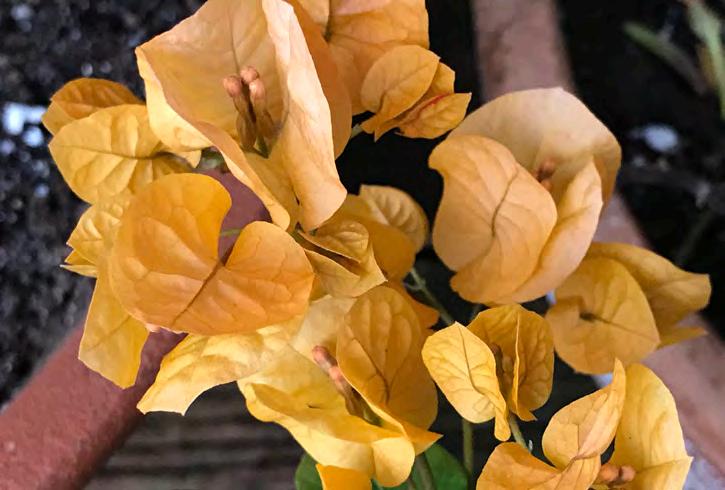
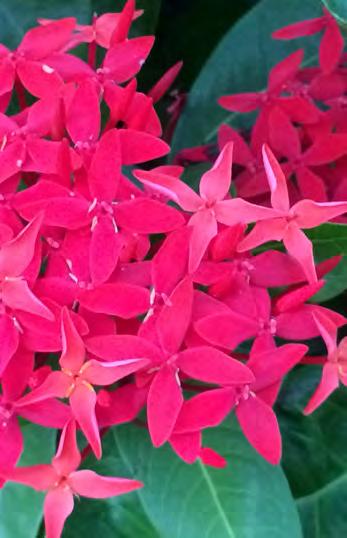
To strengthen the screening affect we curved the original driveway and planted palms as well as casuarina trees, Silver Buttonwood, oleander and crotons. To create a food forest, we saved the existing breadfruit, pomegranate, ackee, naseberry (sapodilla) and lime trees and introduced mango, guava,
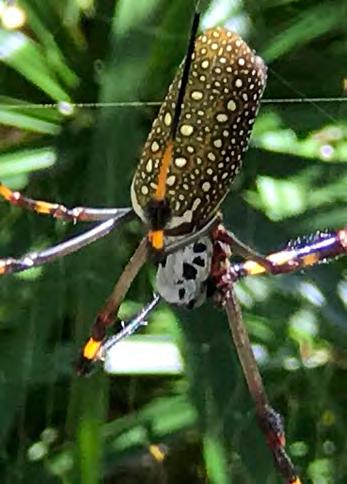
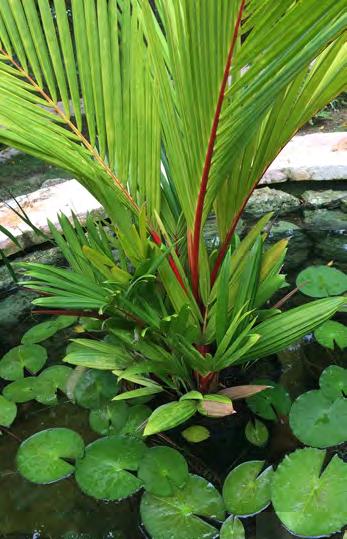
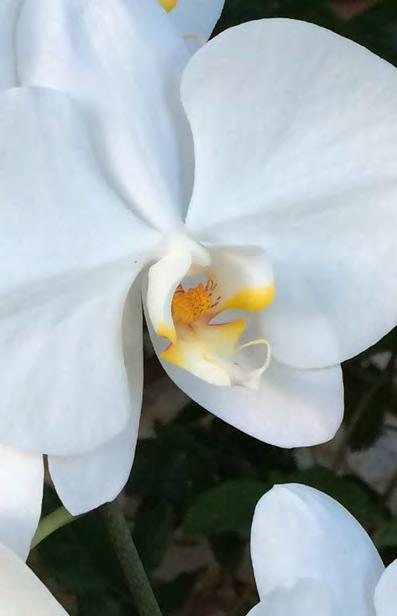 Pale gold bougainvillea
Trichonephila clavipes (orb-weaver or banana spider)
Cyrtostachys Renda (Lipstick palms)
Orchids growing in fig trees Ixora, an evergreen shrub
Pale gold bougainvillea
Trichonephila clavipes (orb-weaver or banana spider)
Cyrtostachys Renda (Lipstick palms)
Orchids growing in fig trees Ixora, an evergreen shrub
Otaheite apple (coco plum), plantains, bananas and calabash. To reduce the sun’s glare, we preserved ancient trees such as Guango and Brasiletto, and planted various fig trees. We deepened the verandahs, added overhanging roofs and created garden beds all around. To create a lush beach side environment, we gradually replaced much of the parched lawn with a riot of flowers, bromeliads, and sea grape, flowering Poui and coconut trees.
What have We Learned?
• Once the construction noise and dust settled, we were thrilled that the lizards and caterpillars had survived. So had the warty toad, the mongoose family, baby frogs, zigzag spiders, moths and hummingbirds.

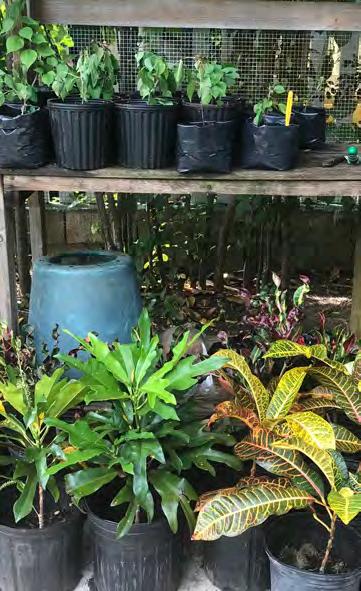
• The flowering vines at the entrance could not withstand the relentless salt wind so we replaced them with hardy agaves.

• We overplanted the driveway area. As a result, some understory trees and shrubs struggle to get enough light beneath the Bismarcks.
• The house is much shadier and more welcoming with the greenery but we had awnings installed on the west side, where the sun’s rays are strongest.
• Soil and nutrients rapidly leach through the limestone honeycomb rock after heavy rains. Even though we have a massive compost pile, we must regularly truck in topsoil and manure.
• Recently, the shrubland across the road has been bulldozed, drilled and pounded for new villas and new shorelines. We’ve become hyper aware of our responsibility to plant vegetation that will offer nourishment and shelter for the refugee species such as parrots and whistling ducks. Our aim is not to manicure but to mind our interaction with plants and land. We have taken additional steps to optimize our environmental impact, such as proper plumbing, water use, lighting practices and our ongoing resistance to the powerful commercial pressures to use toxic herbicides and pesticides. We’re blessed with a
team of amazing people who help us maintain the health of the garden. For instance, trees require regular pruning and examination for evidence of termites, white fly, dead branches, or roots seeking plumbing pipes.
The grandchildren who’ve arrived in the intervening years have grown up respecting the insects, reptiles and butterflies around them. It’s a joy to observe them exploring the trees and flowers I cannot name here and sharing in the joys of working with the soil and the seeds.
torontobotanicalgarden.ca 28 Spring 2023
Silver Bismarck Palms line the driveway
Tropical plants in nursery

“our aim is not to manicure but to mind our interaction with plants and land.”
Adenium obesum (desert rose) and Mansoa alliacea (garlic vine)
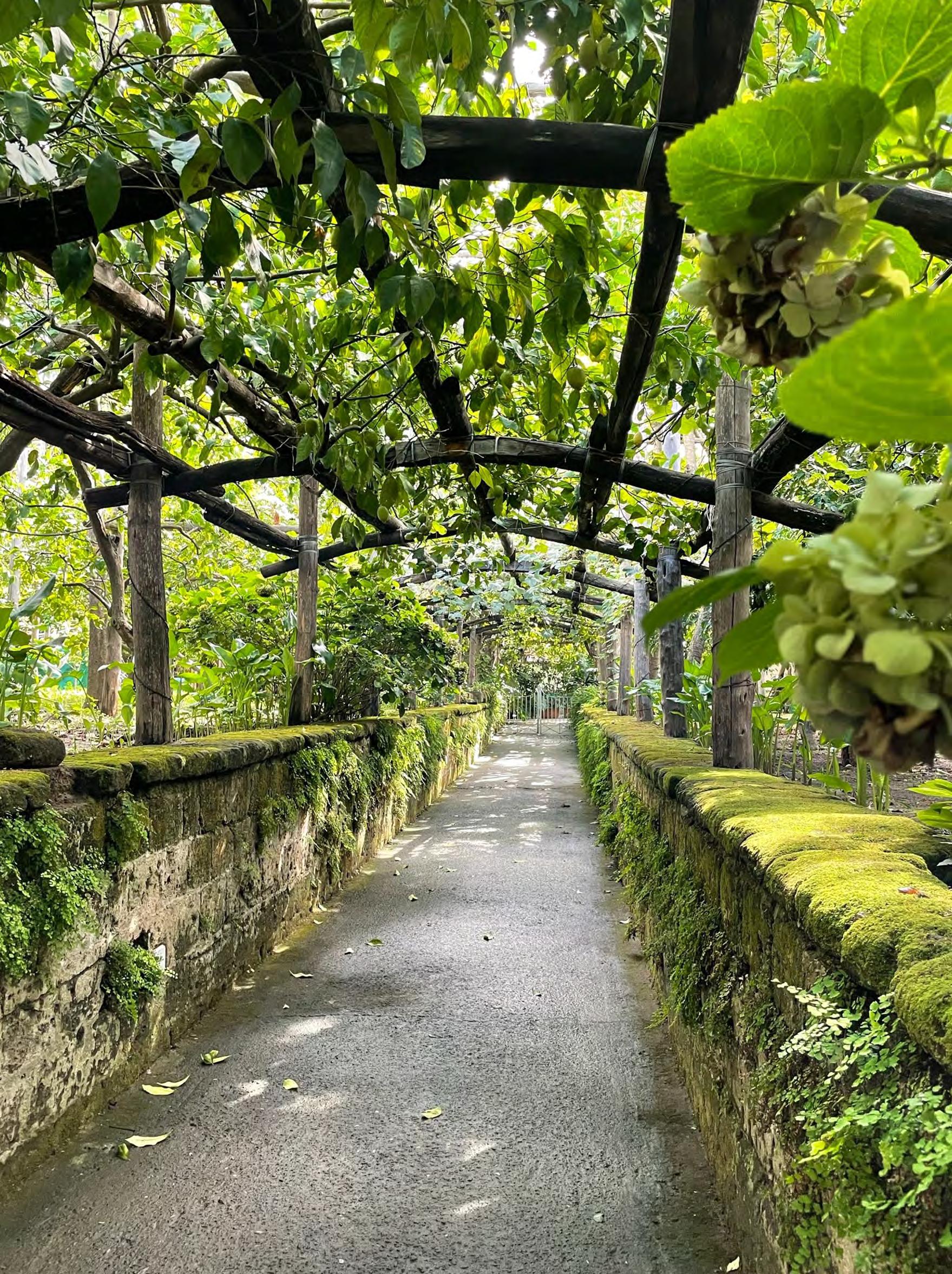 Lemon Grove in Giardini di Cataldo, Sorrento
Lemon Grove in Giardini di Cataldo, Sorrento
Sojourn in sorrento
on the amalfi Coast everything seems set in a garden
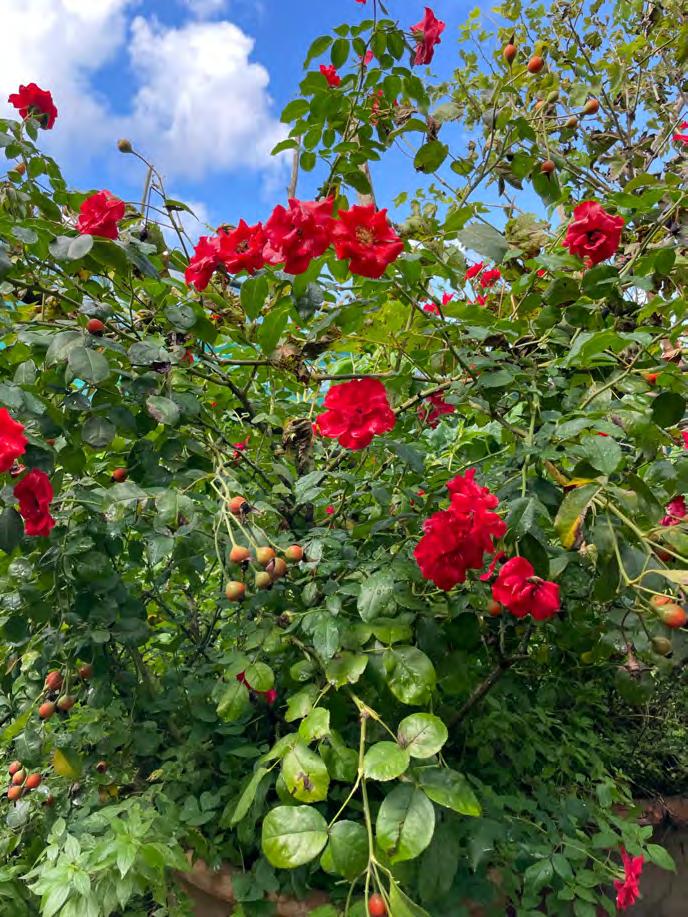 By Gail M. Murray
By Gail M. Murray
Just two hours south of naples, my mid-september tour to the Amalfi Coast of Italy revealed a friendly, walkable city perched on cliffs 30.5 metres (100 feet) above the sea. Known as a shoppers’ delight, sorrento has charming shops selling leather goods, high fashion finds as well as all sorts of other goods embellished with lemons.
Photos: Gail
M. Murray
torontobotani C alG arden.C a 31 sP rin G 2023
Roses at Mazerella Farm
ABove: ocean view from Positano
BeLow: Statue in Hotel excelsior vittoria garden
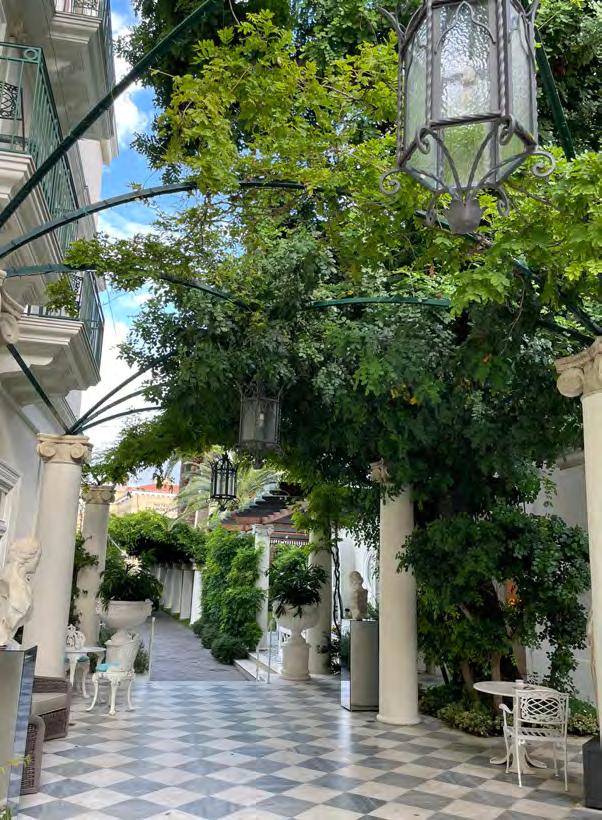

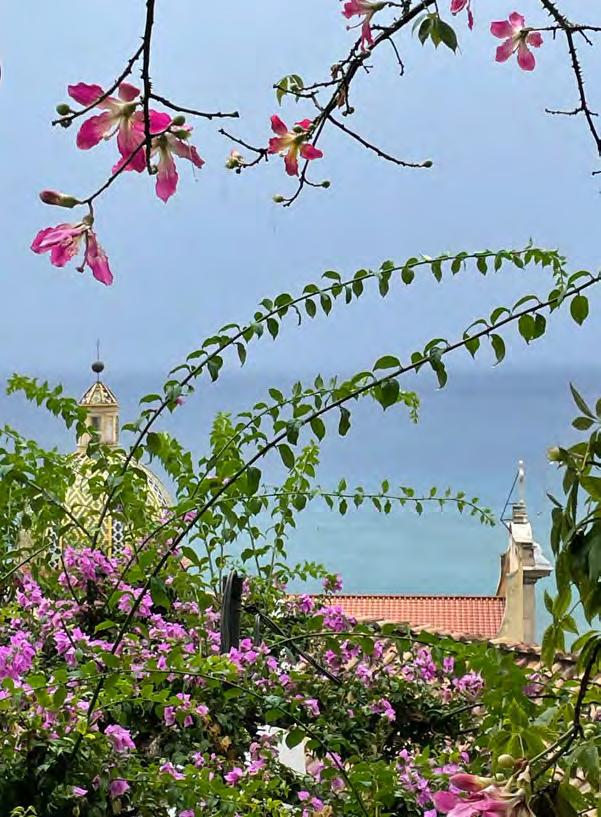
ABove: Hotel excelsior vittoria atop the cliff
BeLow: open lobby of Hotel Bellevue Syrene

Lemons are gold in Sorrento the sorrento lemon, famous throughout Italy, gets its name from the town of sorrento. Lemons were brought here from Hesperia by Alexander the Great’s armies and then cultivated by the Moorish conquerors. Many gardens along the Amalfi Coast began as farms, terraced with macere (containment walls). “Citriculture” takes pride of place here as the famed limoncello liqueur attests. Don’t leave sorrento without a visit to a lemon grove. Agruminato, the name of the citrus garden at Giardini di Cataldo is typical of those found on the sorrento Peninsula. Located off the main street in the heart of sorrento, this small family-run lemon grove offers divine tastings of limoncello liqueur. the trick is to use the freshest lemon peel and serve this liqueur at room temperature. Chilling increases the sweetness.
Hotel Gardens of Sorrento
As A g A rdener and toronto Botanical Garden tour guide, you know I had to visit the gardens. Hotel Bellevue s yrene and Hotel e xcelsior Vittoria are both perched on the rugged cliffs offering stunning views of the Bay of n aples.
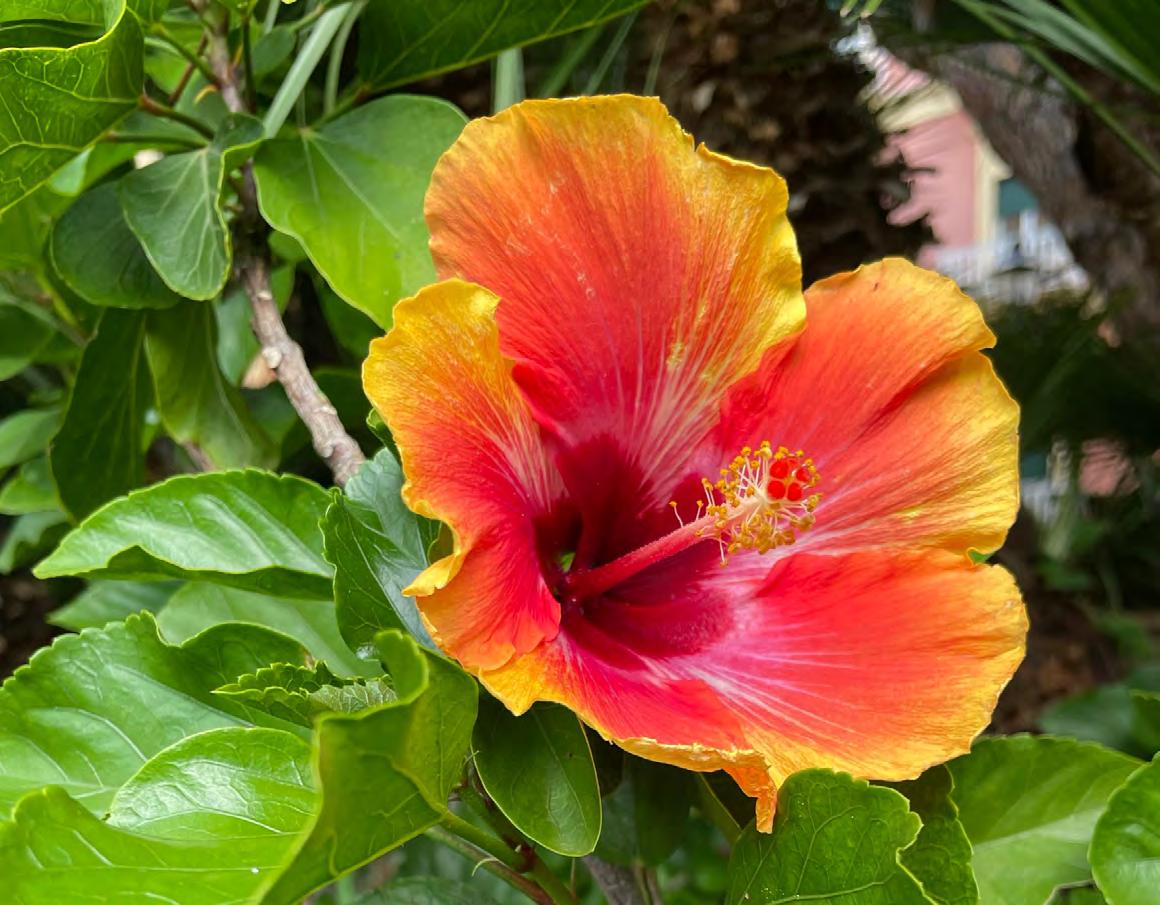
Hotel Bellevue syrene is centrally located near the Villa Comunale Park and the Cloisters. An imposing entrance and long walk take you past luxurious palms and to the other worldly La Pergola balcony restaurant with its white wrought iron tables highlighted against the blue azure sky and the brilliant blue of the bay.
Hotel excelsior Vittoria, near the main square, holds pride of place. entering under an imposing arch, you take a very long paved driveway lined with tall umbrella pines, silver olive trees and luxurious gardens to the other side where classical roman statues come into view. to enter the hotel itself, you pass through another long path with ivy cascading down brick walls and hedges of hibiscus.
Capri
A short ferry ride from sorrento to the island of Capri takes you to the town of Anacapri, featuring Villa san Michele’s very special cliffside garden designed by swedish doctor Axel Munthe. the outer path runs along the cliff on three sides of the home and is framed by layers of lush, terraced plantings and tumbling water channels that provide ambient sound. Here there is the blush of pink oleander and scarlet begonia and wisteria
torontobotani C alG arden.C a 33 sP rin G 2023
Hibicus hedge at Hotel excelsior vittoria
climb the pergola. As the path moves around the perimeter, it winds through marble columns giving way to towering umbrella pines that reach up to an azure sky and look down upon the sapphire of the tyrrhenian sea.
Ravello
rAvello is high in the Lattari Mountains boasting two unique villa gardens: Villa rufolo and Villa Cimbrone.
Villa rufolo with its Moorish towers and expansive views, makes a stunning backdrop for the concerts that take place in this glorious garden in summer. on two levels, juxtaposed against the sea, umbrella pines reach skyward. the gardens take on a magical quality with profuse blooms, fountains and the medieval Church of Annunziata.
With corridors of hydrangea, ivy-clad stone walls and arching wisteria, Villa Cimbrone features serene cloisters that radiate a spiritual feel. In the rose garden pale pink petals wax ethereal and a copy of Donatello’s David stands tall. the statuary reminds me I’m in a renaissance Garden.
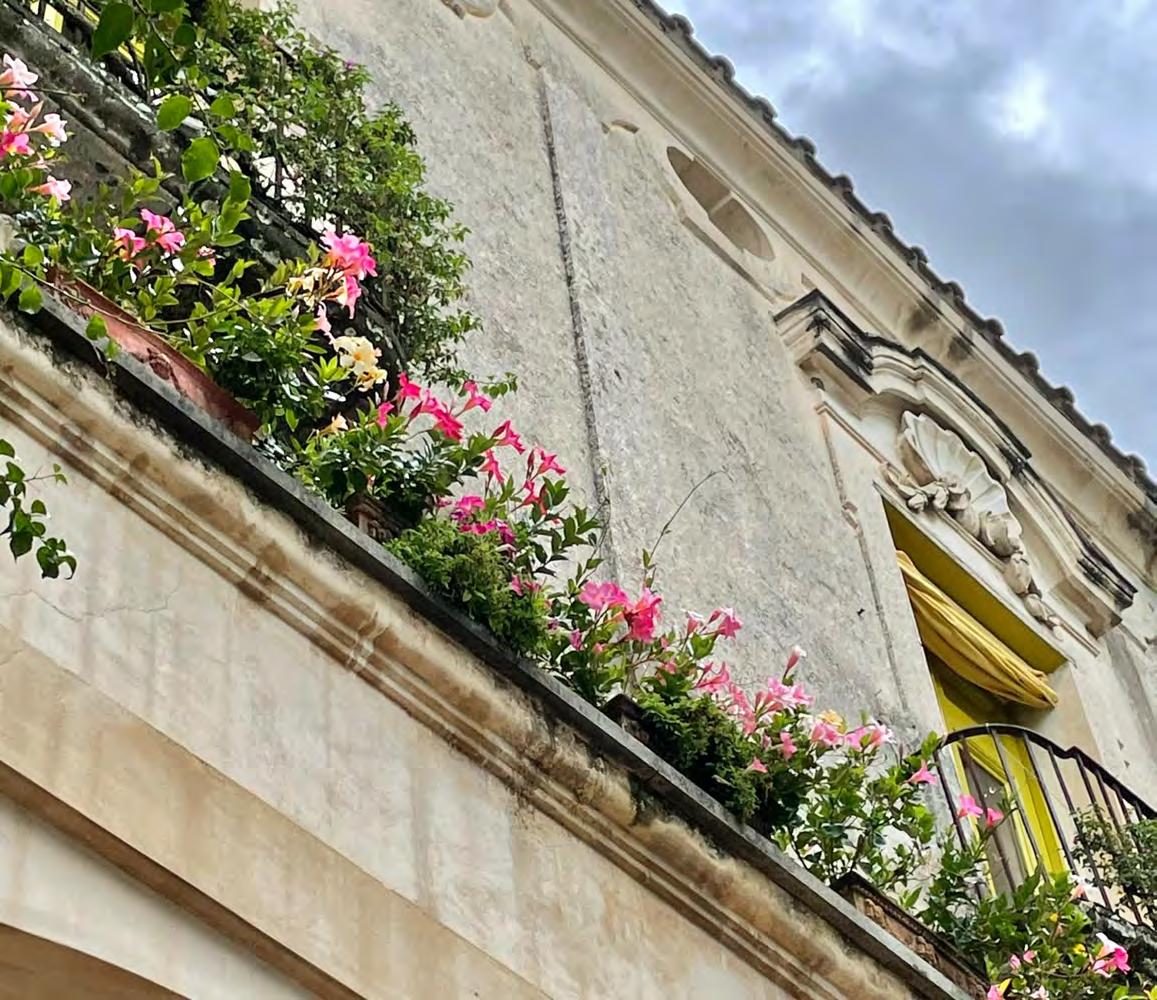
Cooking class a highlight not someone who likes to cook, but I look forward to being with an Italian family in their home for a cooking class. t here are 20 in our group, keen to learn the basics of southern Italian cooking—fresh local ingredients, herbs and a good heart. What you cook depends on the season.
We use lots of virgin olive oil, oregano, tomatoes, basil, mozzarella and ricotta. We prepare cucumber/ tomato salad, baked potatoes and garlic, cheese stuffed meatballs, pasta stuffed with ricotta, lightly breaded zucchini flowers and lemon tiramisu, While everything cooks we learn about wine making. We dine on the pergola of their heavenly garden among fruit trees and hydrangea. this simple, yet glorious, experience is a highlight of the trip.
everywhere on this adventure I’ve been aware of the luscious plant life, breathtaking landscape, old world architecture and warm, friendly people. that’s my Italy.
torontobotani C alG arden.C a 34 sP rin G 2023
window planter in Hotel Palazzo Marat, Positano
Female Travel Groups empower women to get out and see the world
Ladies, are you yearning to travel, yet hesitant to go solo? Perhaps you’re single, widowed, divorced, your girlfriends aren’t interested or can’t afford it, or your husband would rather play golf? you don’t want to feel like a fifth wheel among couples? Consider travel organizations that cater to women such as: Journeywoman, Wander Woman, Girls’ Guide to Paris & beyond, today’s Woman traveller, and Womens travel network.
although not the same as a specified garden tour, tours catering to women often include garden visits and nature destinations. i traveled with the Womens travel network on this trip and was not disappointed.
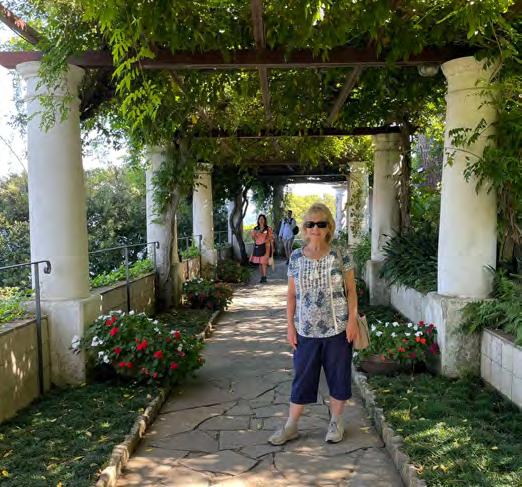
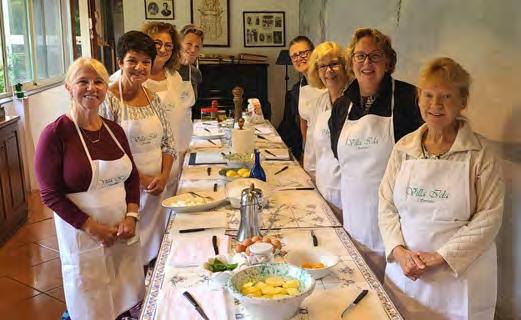
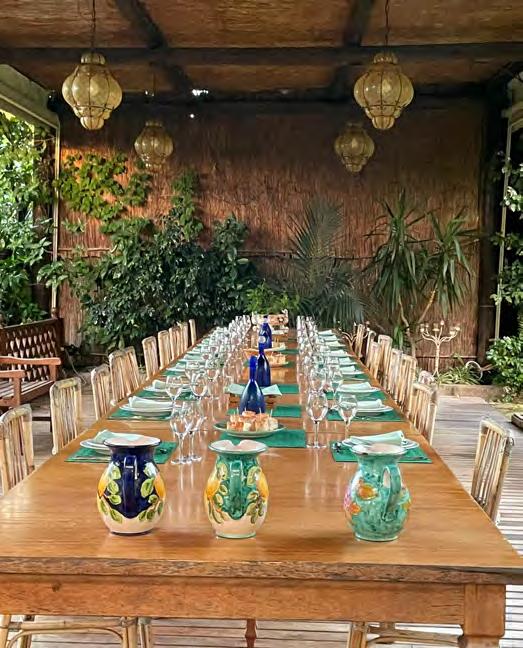
experienced travel professional, debbie ross, created this small company 20 years ago “to empower women to get out and see the world”. all the planning is done for you; hosts ensure everything runs smoothly. Groups are small: from 10 to 16 people. trips range from exotic locales such as bali and Galapagos to britain and italy. i chose amalfi based in sorrento, italy. over a ZooM call, debbie introduces us to our fabulous host deb K.; we meet fellow travelers as debbie discusses all the trip details. so reassuring.
in the age of CoVid, it is comforting to meet everyone at a relaxing airport lounge before flying across the pond. you are welcome to arrange your own flight but how bolstering to travel as a group. once checked in at hotel Plaza sorrento, we gather on the rooftop, the Mediterranean sparkling in the distance, to savour a limoncello spritzer.
our well-designed itinerary encompasses a variety of interests, a balance of scheduled excursions and free time to reflect or pursue personal interests. Without this group, i’d be on the couch with netflix. i feel safe and secure. drivers, local guides and restaurants are all preselected and vetted.
our local guide, roberta, meets us at the naples airport, charming us with her genuine warmth. throughout our holiday, she guides us through her city on a two-hour orientation, on the ferry to Capri, a minibus to anacapri amid a myriad of tourists and a picturesque boat tour around the fabled isle. her knowledge and passion bring ancient Pompeii to life.
it is relaxing to have dinner companions at a wide range of ristoranti. We share past travel adventures, shopping finds (elegant Capri watches) even re-entering the dating scene. it is a leap of faith for me to travel solo with people i have never met, yet here i am toasting and laughing like i‘m with my girlfriends back home! our leader, deb, is calm, responsible, fun and empathetic. she sets the tone.
torontobotani C alG arden.C a 35 sP rin G 2023
Gail Murray on her Sorrento sojourn
Table set for cooking class dinner.
Cooking class participants ready to dine
Learn the right plants for bird welfare
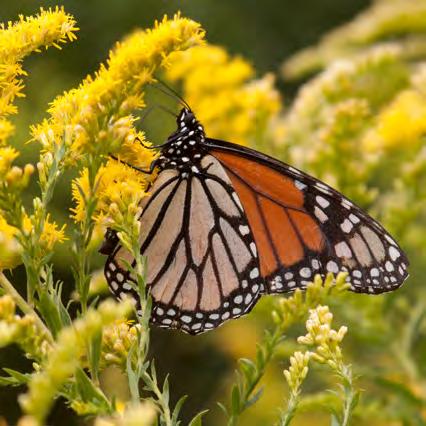
100 Plants to FEED THE BIRDS Turn Your Home Garden into a Healthy Bird Habitat
Reviewed by lorraine hunter
Improving backyard habitats to sustain birds does not have to mean replacing backyard feeders according to author Laura Erickson. But even the best feeding stations can’t match the importance of the right plants for bird welfare.
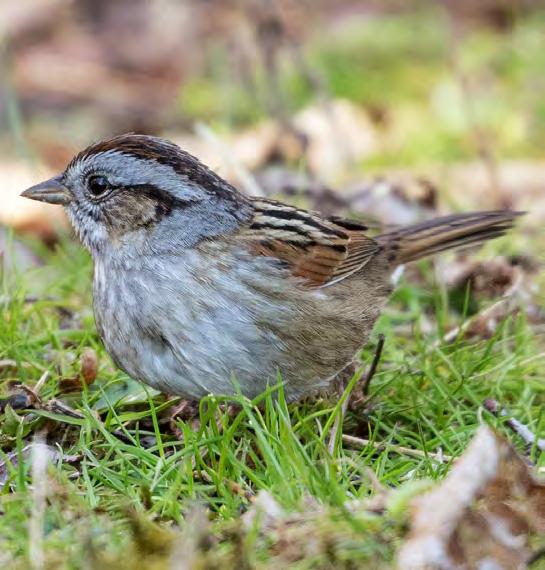
As natural habitat shrinks, bird-friendly landscape plantings are increasingly important. In this beautifully photographed and illustrated book, Erickson introduces readers to the intimate relationships between birds and some 100 native trees, shrubs, grasses, flowers, lichens, vines and cacti across North America. She recommends species and the insects and birds they attract. She also explains how you, as a gardener, can provide year-round nutritional and nesting support for birds of all kinds.
In addition, the author lists some ecologically harmful, invasive plants not to invite into your yard, such as purple loosestrife, oriental bittersweet and common hawthorn.
Erickson stresses the importance of planning for all seasons. “Hard as it is to believe, trees and shrubs provide a great deal of insect food even when temperatures are double digits below zero, mostly in the form of eggs and pupae hidden in the crevices of bark,” she writes. (Page 15)
Comprehensive lists make plant sourcing for all US states and Canadian provinces easy. There are useful maps for each entry and a list of North American native plant societies including several in Canada. This award-winning author has served as science editor at the Cornell Lab of Ornithology and as columnist and contributing editor for Birdwatching. She produces For the Birds, a long-running public radio program and podcast and has written several other books about birds.
Tips, such as “Scrub those birdbaths every three to four days to avoid time for mosquito eggs to hatch” are found throughout the book.
100 Plants to FEED THE BIRDS
Laura Erickson (Storey)
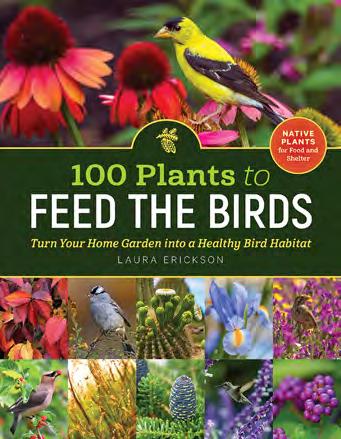
xxxxx xxxxxxx Book shelf
Photo:
Toron To B oTanica LG arden.ca 36 Sprin G 2023
PLANT SALES
Saturday, April 1, 10:30 a.m. to 4 p.m.
HELLEBORE SALE
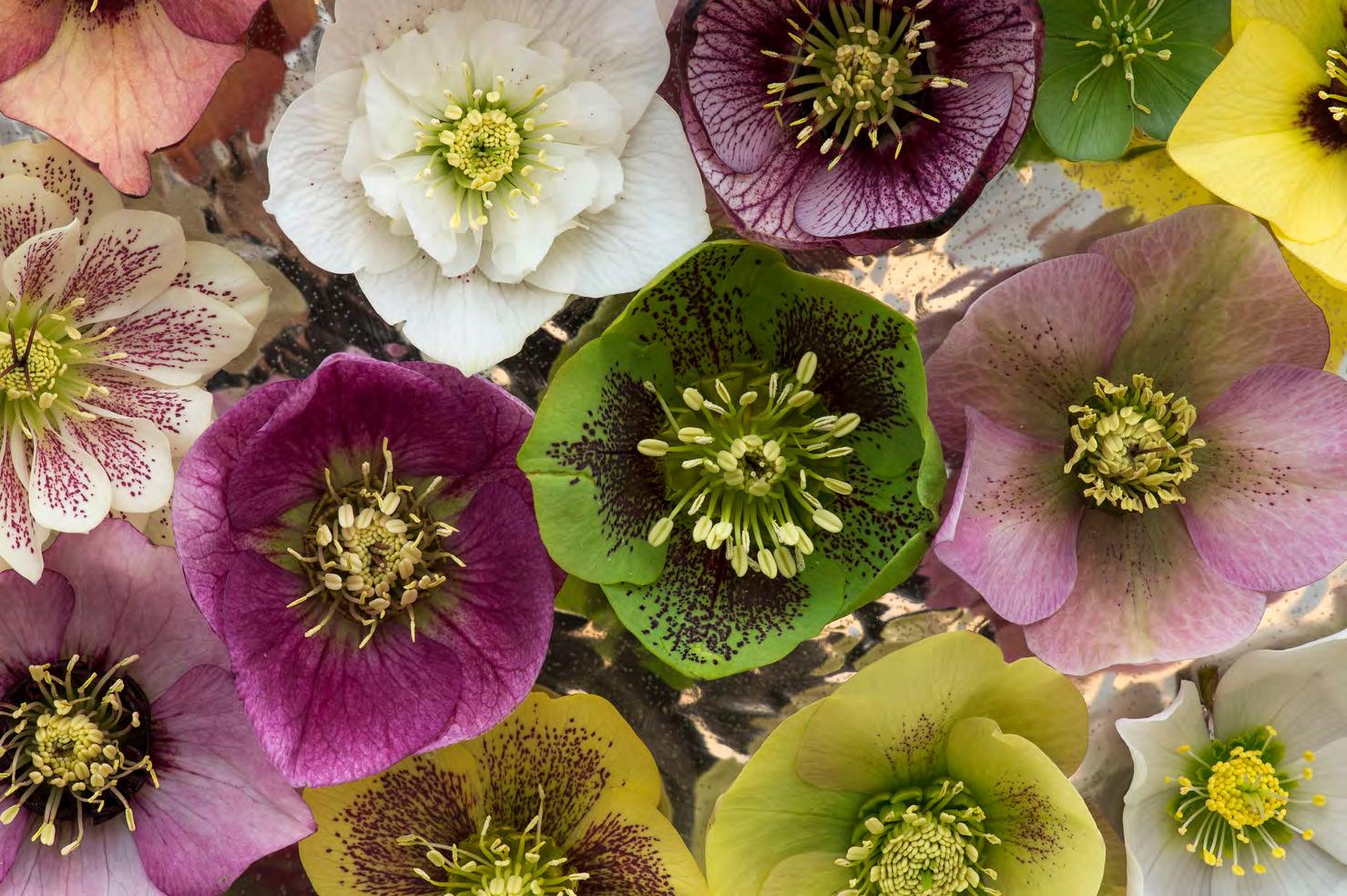
Friday, May 5, 1 to 7 p.m.
SPRING PLANT SALE
MEMBERS ONLY PREVIEW AND SHOPPING
Saturday and Sunday, May 6 and 7, 10 a.m. to 4 p.m.
SPRING PLANT SALE
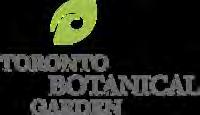

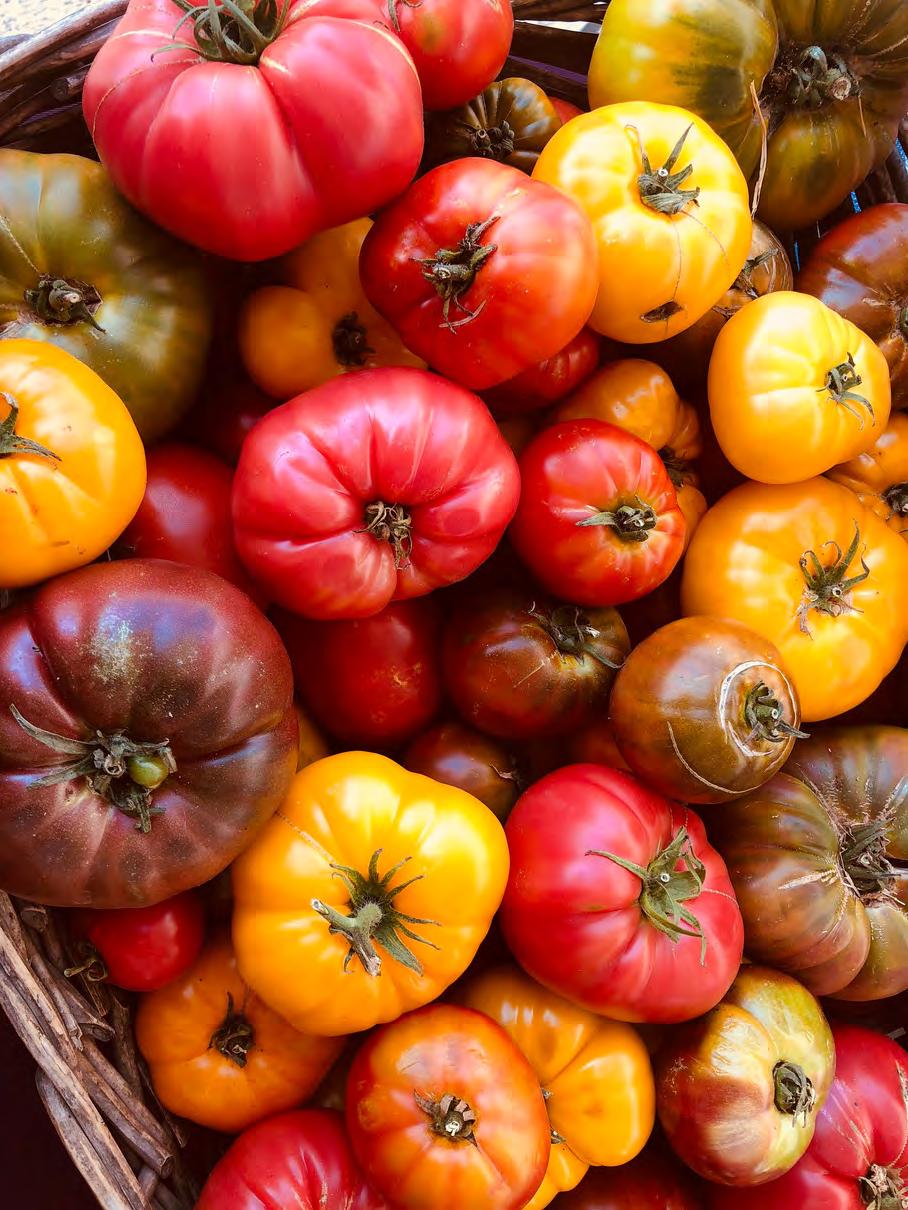
OPEN TO THE PUBLIC torontobotanicalgarden.ca/events
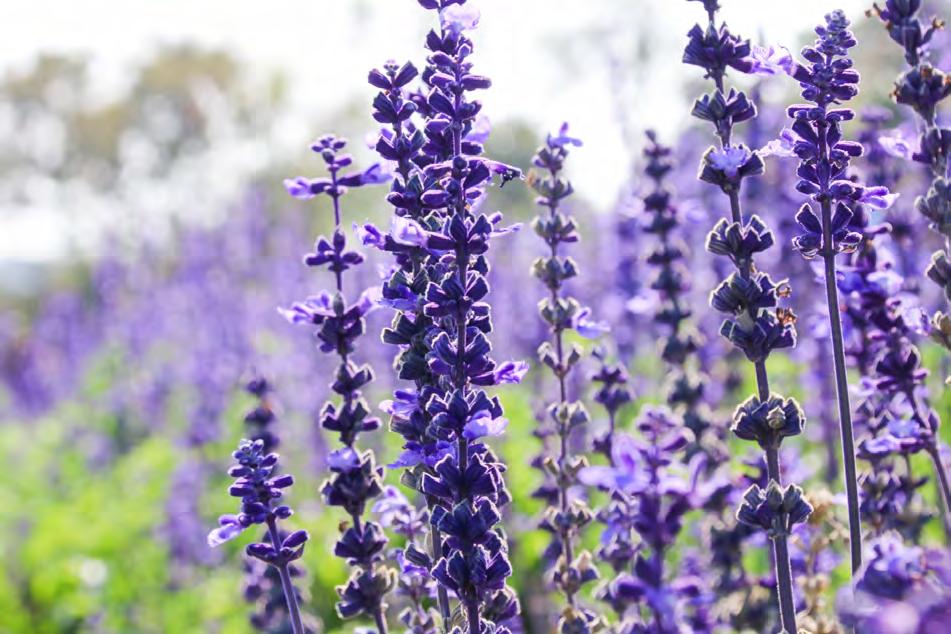
p iece S Puzzle
botanical artwork makes ideal jigsaws
Mushrooms
Reviewed by Walter Sliva
Mushrooms is a piece of artwork made for nature lovers–nature of the mushroom variety, of course! The puzzle construction by Artisan is excellent. The 1,000 pieces are hard-coated to minimize fraying and produce a strong interlock between pieces that also confirms a perfect match.
i love the interesting detail and variety of shapes and sizes of the subject matter by artist Nathalie Lété. Each species depicted is a unique colour and shape, and it
was a pleasure tracking down and completing each one.
i enjoy working on a picture that has enough detail that i can search through the unmatched pieces and find one particular piece to complete a scene. mushrooms is one of those, and highly recommended!
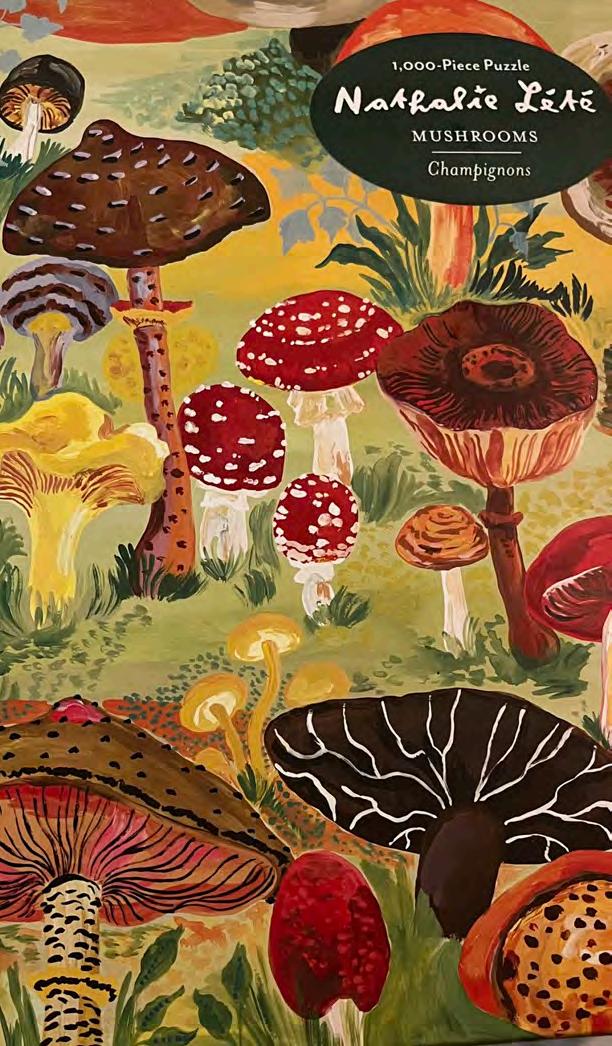
Dancing Butterflies
Reviewed by Walter Sliva
This 750-piEcE puzzle depicts a 19th-century print by John Derian that features seven species of butterflies hovering over a beautifully

etched thistle. it’s a lovely art-meetsscience snapshot of the natural world.
The cream-coloured border and monochromatic etching are initially quite daunting, but the puzzler quickly learns to use the subtlest clues to help pull the scene together.
overall, a calming and relaxing experience, as you piece together a true work of art.
torontobotanicalgarden.ca 38 Spring 2023
Volunteers
TBG volun T eers deserve our appreciaT ion
By Sue Hills head of volunteer services and tour guides
We have a terrific team of TBG volunteers. April is Volunteer Appreciation month giving us the perfect opportunity to let them know how much they mean to us.
We ended 2022 profoundly grateful for their time and their talents, without which our programs and events would not have been the success they were, our gardens would not have been looked after and our services could not have run smoothly.
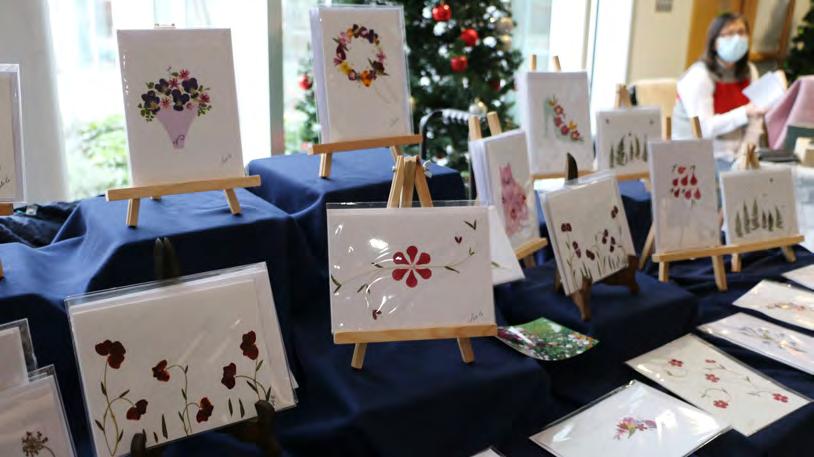
in total, TBG volunteers contributed over 10,300 hours of support, and that does not include all the time spent on behind the scenes committees (Through the Garden Gate planning team, Trellis committee and pressed Flower endeavours to name just a few).
Given that 2022 was a gradual return post pandemic, this is noteworthy indeed. With this quantity of hours came the quality of multi-talented people to fulfill roles ranging from retail and library services to special events and education ambassador roles, to hands-on gardening and leading tours. on behalf of TBG, Thank You!
We began 2022 with 161 volunteers (who helped keep us going during the pandemic years). We ended 2022 with 266, the majority of whom we hope will be there for us again this year. We hope to welcome as many volunteers who can attend to our volunteer appreciation event in April, as a chance to say “thank you” in person!
Photo: xxxxx xxxxxxx torontobotanicalgarden.ca 39 Spring 2023
We began 2022 With 161 volunteers (Who helped keep us going during the pandemic years). We ended 2022 With 266,the majority of Whom We hope Will be there for us again this year.
A selection of the many one-of-a-kind greeting cards made by volunteer members of the Pressed Flower group.
Slow growing Hawort H ia a Colle C tor’ S Delig H t
By Georgie Kennedy
Have you met tiny Haworthia truncata var. maughanii (Maughan’s Haworthia) and her hundreds of cousins? You’ll be enchanted once you do. When placed at eye level near a window, this plant attracts the attention of children and seasoned gardeners alike. Curiosity compels them to hold it up and marvel at the thick, window-like leaves.
A succulent native to shady locations in South Africa and neighbouring countries, genus Haworthia has become a trendy houseplant worldwide. In its natural habitat, the leaves of the species Maughan’s look like stubby flattopped fingers protruding from stony ground. A person could walk by and not notice them. In times of drought, the roots contract to pull the plant deeper into the earth, thus protecting it from the elements and from herbivores. No single description could encapsulate the endless and
fascinating shapes of this genus. Some grow in rosettes, and others look like a bunch of bananas.
Haworthia is slow growing and needs little care in the home. Yours will be potted in a succulent mix at the nursery where you purchase it. Do not repot for at least a year. Be sure the container drains freely after each watering. An overly sunny location might cause leaf tips to burn so place it slightly back from a south- or west-facing window. A pro tip from Wing-Hong Tse of Kim’s Nature: polish the stubs with a wet cotton swab and they’ll look like precious gems.
A miniature novelty plant, Haworthia is easily transportable and perfect for small spaces, so you can start a collection. This low maintenance houseplant makes a lovely gift for beginning gardeners and bonus… it’s nonpoisonous to pets and humans.
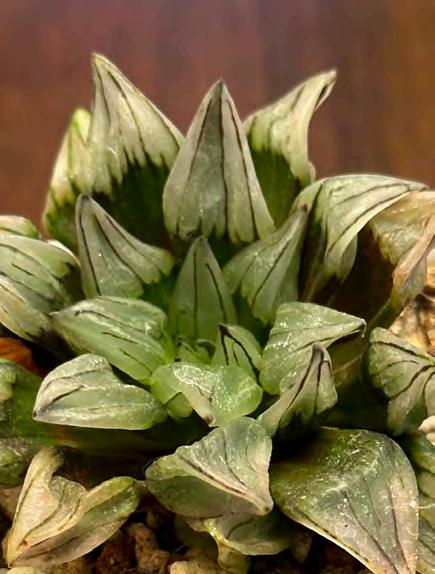
SouRceS: https://worldofsucculents.com/haworthia-truncata-maughanii/ http://www.llifle.com/encyclopedia/SUccUlentS/Family/aloaceae/11540/haworthia_maughani llifle

torontobotanicalgarden.ca 40 Spring 2023 p hoto S : g eorgie Kennedy
houseplant profile
Haworthia Rainbow
Haworthia Watermelon
The Teaching garden
a ‘secret’ place for children to connect with nature
By Natalie Harder Director of Learning
TBG’S TeacHING GaRdeN is a special place in the city. created in 1998, this project was made possible with the garden club of toronto’s support and is lovingly known by many as a ‘secret’ garden. the teaching garden invites all children to connect with nature and plant and care for a garden. these experiences nurture a love of gardening and offer an opportunity for children to taste delicious new fruits and vegetables. parents, grandparents and caregivers might like to know that kids who participate in gardening programs ate more vegetables than they did before the program! *
the teaching garden is a great space to experiment and explore with food. radishes that look like easter eggs? beans as tall as a toddler? ‘Watermelons’ for a fairy? yes, to all of them! While some children (and adults) might be nervous to try odd looking vegetables, with a little patience these novelties are a great introduction to the magic and joy of gardening while getting some nutritious vegetables into their diet. We will always encourage the kids to share their own opinions — they might not like the new green or root (and that’s okay!), but they also might be pleasantly surprised about the wonderful tastes they can find in the garden.
What could you try in an experimental garden? here are some suggestions from the teaching garden as well as some new experiments you might see in the coming years!
• easter egg Radishes: easter egg radishes ranging from shades of red, purple and white, are fun and easy to grow. ask children their favourite colour and see if they notice any differences. blind taste test anyone?

• cucamelon: don’t be deceived — these mysterious fruits may look like a tiny watermelon, but they taste like a cucumber with a citrus tang. have you had a picnic for a fairy? you might have to with the cucamelons. try cutting them into wedges and see if children can resist giving it a tiny bite. these may be a bit tricky to find in the foliage so make it a scavenger hunt!
• currant Tomatoes: pluck these off the vine and munch on them right in the garden. but, watch out! Since, they are tinier than cherry tomatoes, it’s easy to eat a lot of them in one sitting.
• Long Beans: if you don’t want to go tiny, you can always go big! long beans (or yard long beans) grow up to a metre (3 feet) long!
• Ground cherries, related to tomatillos, grow with a delicate lantern. peeling off their papery lantern is half the fun.
• Nasturtium: don’t forget the flowers! Surprise kids by letting them know that they can actually eat some petals and leaves. although some may be a bit spicy, they will surely leave everyone with a memorable experience, a chance to bond with gardening or share a great story with their friends. Important Tip: don’t eat just any flower in sight. children should check with an adult before trying something from the garden.
We love for kids to come and taste all the veggies in the garden. We encourage just a tester, however, because all of the extra produce is donated to the north york harvest Food bank.
the teaching garden is open to the public when programs are not in session. the tbg’s summer camp programs are also a great way to get kids exploring in the garden!

*according to a study from the University of texas. https://www.sciencedaily.com/releases/2021/02/210204131408.htm
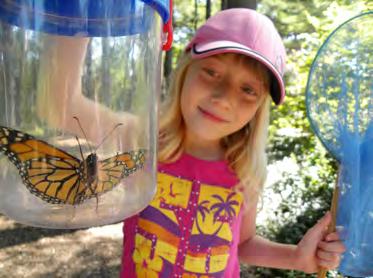
torontobotanicalgarden.ca 41 Spring 2023 torontobotanicalgarden.ca 41 Spring 2023
Tafelmusik at the Garden Joyfully welcomed at their first winter performance at the TBG on February 26, Tafelmusik returns for concerts in the Floral Hall at 2 p.m. on Sunday, March 26 and Sunday, April 30. Renowned for dynamic, engaging and soulful performances, Tafelmusik performs for audiences across Toronto and digital audiences around the world. The critically acclaimed Tafelmusik Chamber Choir, and its director Ivars Taurins, often share the stage with the orchestra. Tafelmusik’s recordings on the Sony, CBC Records, Analekta, and Tafelmusik Media labels have garnered ten JUNOs and numerous international recording prizes. Tickets are $25 for non members; $23 for members. For more info: https:// torontobotanicalgarden.ca /enjoy/music/

Good Things Are Happening
Farmers Market to relaunch on Earth Day. tbg’s beloved Farmers Market will be returning in partnership with appletree Markets & events. the market will run May 11 through october 5 on thursdays from 3 to 7 p.m. with a kick off earth day eco Market on saturday, april 22. More details to follow.

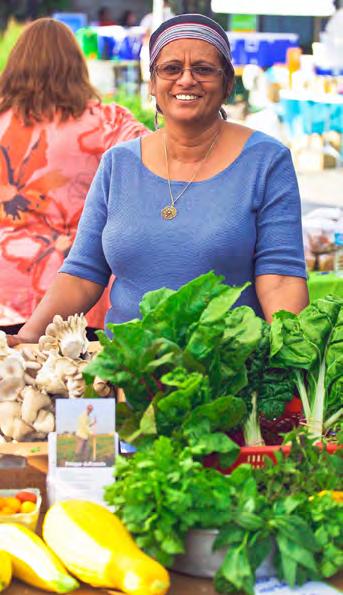
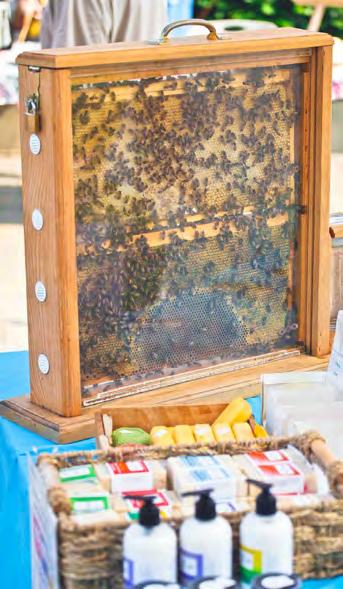
torontobotanicalgarden.ca 42 spring 2023
NEW! Nipy’s soNGWalks

The award-winning Amadeus Choir, a semi-professional choir of auditioned voices from all parts of the GTA and surrounding areas will perform at the TBG on Saturday, May 27. The premier of a new major work about Indigenous water sovereignty from Cree cellist and composer Cris Derksen will be preceded by an immersive outdoor prelude performance.
Botanical Footwear Exhibit tbg and bata shoe Museum will launch a special shoe exhibit at the museum in late april. the exhibition looks at the use of floral motifs and plant-based materials on footwear from around the globe. it will contain both historic and contemporary artifacts such as 18th century Wendat moccasins, 19th century shoes from india and customized nike sneakers. these objects sometimes use floral motifs symbolically, and sometimes decoratively. the exhibit also includes footwear made of plant materials such as cotton, rice straw, and grass. nature will be explored as both an inspiration and a resource for footwear fashion. Watch for more information on this over-the-top exhibit.

Ravine symposium

Returns tbg’s Urban ravine symposium will be back in november 2023! the benefits of our urban ravine systems have become even more apparent in the past few years. they provided us with a quick escape to nature and a respite from the city when we needed it most. However, the ravines face multiple challenges from invasive species to extreme flooding. the Urban ravine symposium will provide an opportunity to explore creative solutions to the challenges we face in our urban ravine systems and celebrate the incredible ecological benefits they provide. stay tuned for early bird registration.
GET THE JUMp oN spRiNG & sEEDy saTURDay
TBG’s annual Horticultural Open House and Seed Exchange will be relaunched on Saturday, March 25 from 10 a.m. to 4 p.m. with exhibitors from Toronto’s horticultural societies, garden clubs, environmental organizations… and more. This one-day garden extravaganza includes FREE talks and demos, and gardening advice from Toronto Master Gardeners. FREE admission. Become a member and receive FREE parking. $2 suggested donation at the door.
torontobotanicalgarden.ca 43 spring 2023
t a F el MU sik, F
lickr, pexels
LAVENDER CANDLES Diy
harness the healing power of your garden and bring serenity into your home
By Jenny Rhodenizer Director of Marketing & Audience Engagement
Lavender is a wonderful addition to gardens of any size and can be used for many DIY projects. A flowering plant in the mint family, lavender is easily identified by its beautiful colour and pleasant fragrance. It’s also known to provide many health benefits from promoting sleep to reducing blood pressure. Lavender has positive effects on mood, reduces stress, and promotes relaxation.
You can easily make your own candles with other flowers or herbs too; just make sure to always use dried botanicals, keeping them away from the wick and immersing them into the wax to ensure they don’t catch fire.
What you’ll need
• Wide-mouth jars, or upcycle glass vessels
• 4 cups of soy wax flakes (for candles)
• Pre-waxed wicks with metal tab
• Tweezers, chopsticks, paintbrush
• Lavender essential oil for scent
• Dried lavender leaves and flower stems
How to make them
• Harvest small, young lavender flowers and leaves on thin, delicate green stems (not the older woody stems with large flowers).
• Put them in a vase or hang them upside down to dry for about a week.
• Cut the lavender stems so they will sit at least 2.5 centimetres (1 inch) below the rim of the jar or vessel.
• Add soy wax flakes into a double boiler and heat until liquified. When melted, the flakes will melt to about half the amount in liquid form.
• Using tweezers, dip the dried lavender blooms in the melted wax. Working quickly, place the stem on the inside of the glass; press firmly in place as the wax cools.
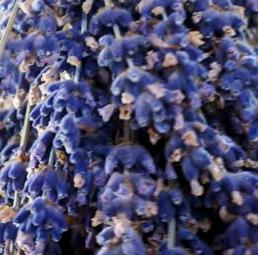

• Brush melted wax over the lavender stem to hold it in place. Continue arranging and adding lavender stems around the inside of the jar
• Add a dab of hot glue to attach the wick to the centre bottom of the glass. Slip the top of the wick between chopsticks resting across the top of the glass to keep the wick straight and centred.

• Add 20-30 drops of essential lavender oil to the melted wax and stir to combine.
• Carefully pour or ladle melted wax into glasses and set them aside to cool for approximately 24 hours.
• Once set, remove chopsticks and trim the wick to ¼" above the wax.
Photos: Jenny Rhodenize R
to R ontobotanicalga R den.ca 44 sPR ing 2023
Centre wicks between chopsticks.
Dried lavender flowers. Side view of setting candles.
Board Chair Gordon Ashworth, v ice Chair Tony DiGiovanni, s ecretary Dianne Azzarello, Treasurer Janice Winton
Barb Anie, Adeline Cheng, Doris Chee, Michele Chandler, Ben Cullen, Lisa Ellis, Susan Grundy, Abdullah Hamidi, Harry Jongerden, Nicole Leaper, Margareth Lobo Gault, Helder Marcos, Haig Seferian
Ex Officio: Christina Iacovino (City of Toronto), Derryn Gill (Garden Club of Toronto), Ingrid Smith (Milne House Garden Club).
The Toronto Botanical Garden (TBG) is a volunteer-based, charitable organization that raises more than 95 per cent of its operating funds through membership, facility rentals, retail operations, program fees and donations. The organization relies on its partnership with the City of Toronto and on the generosity and financial commitment of individuals, foundations and corporations to support the many beneficial services we provide to the community.
Our missi O n: Toronto Botanical Garden connects people to plants, inspiring us to live in harmony with nature.
Our visi O n: Toronto Botanical Garden will be renowned for its display of nature’s beauty and as a dynamic hub for plant-centred learning, conservation and research.
si G n u P FO r GA r DE n E n EW s !
Receive the latest horticultural news and information on events, workshops, lectures and other horticultural happenings. Free registration at https://torontobotanicalgarden.ca
The Garden is open daily from dawn until dusk and admission is free. In-person adult classes, guided garden tours, special events and facility rentals have resumed. Our Visitor Centre, including the Garden Shop, Weston Family Library and public washrooms, is now open daily. Visit Toronto Master Gardeners at torontomastergardeners.ca
Parking: $2.50 per hour. Members & TBG Volunteers, FREE
ExECuTIvE DIRECTOR
Stephanie Jutila sjutila@torontobotanicalgarden.ca
EDuCATIOn
416-397-1355 education@torontobotanicalgarden.ca
DEvELOpmEnT
416-397-1372 development@torontobotanicalgarden.ca
FACiLiTy REnTALS
416 397-1324 events@torontobotanicalgarden.ca



GARdEn ShOP 416-397-1357 retail@torontobotanicalgarden.ca
GARdEninG hELP LinE Toronto Master Gardeners 416-397-1345 torontomastergardeners.ca
GROuP TOuRS
416-397-4145 tourguides@torontobotanicalgarden.ca
hORTiCuLTuRE 416-397-1358 horticulture@torontobotanicalgarden.ca
MARkETinG & COMMuniCATiOnS
416-397-1351 communication@torontobotanicalgarden.ca
MEMBERShiP
416-397-1483 annualgiving@torontobotanicalgarden.ca
TRELLiS MAGAzinE editor@torontobotanicalgarden.ca
VOLunTEER SERViCES
416-397-4145 tourguides@torontobotanicalgarden.ca
WESTOn FAMiLy LiBRARy
416-397-1343 librarydesk@torontobotanicalgarden.ca
EDitoR loRRaine hUnteR
DESigN
JUne andeRson
tRELLiS CommittEE
leanne bURkholdeR
sUe hills
geoRgie kennedy
Jenny RhodenizeR
VeRonica sliVa
VoLuNtEER PRoofREADERS
Jackie caMPbell
lyn hickey
Jean McclUskey
MaRg anne MoRRison
Rose RobeRts
ADVERtiSiNg
416-397-4145
Trellis is published as a members’ newsletter by the toronto botanical garden at edwards gardens
777 lawrence avenue east, toronto, ontario, M3c 1P2, 416-397-1341
Trellis welcomes queries for story ideas, which should be submitted to the editor for consideration by the trellis committee at least four months in advance of publication dates.




opinions expressed in Trellis do not necessarily reflect those of the tbg submissions may be edited for style and clarity. all rights reserved. Reproduction in whole or in part is prohibited without written permission.
Charitable registration number 119227486RR0001



777 Lawrence Avenue East, Toronto Ontario M3C 1P2, Canada • 416-397-1341 fax: 416-397-1354 • info@torontobotanicalgarden.ca torontobotanicalgarden.ca • @TBG_Canada

By TTC: From Eglinton subway station take the 51, 54 or 54A bus to Lawrence Avenue East and Leslie Street. The TBG is on the southwest corner.
Find us on...

DIRECTORY M AST
EA d
h
OF
A BO u T Th E TORO n TO B OTA ni CAL G AR d E n GE n ERAL h O u RS of A d M i SS i O n
BOAR d
di RECTORS
Explore new and future varieties



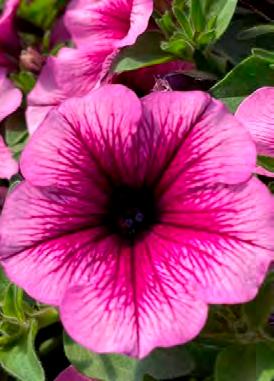
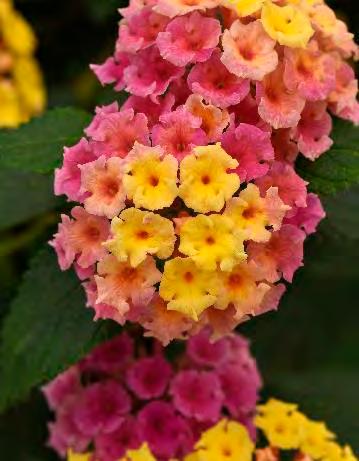
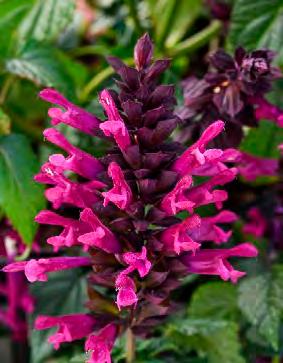
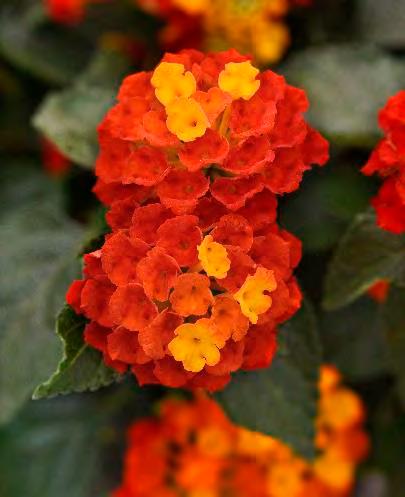
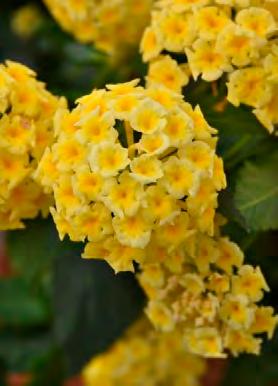
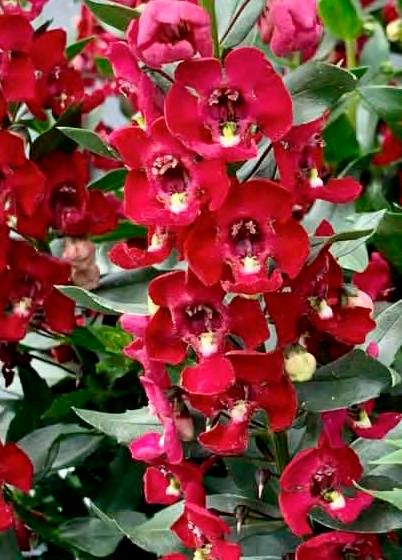
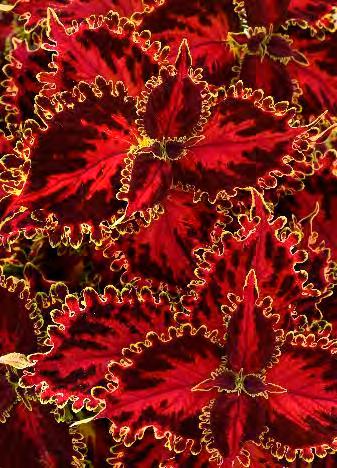
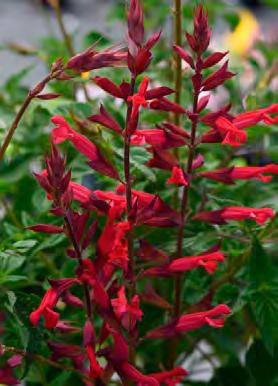

CREATED IN PARTNERSHIP WITH
Salvia Plum Crazy Bloomify Pink Lantana SureShot Pink Vein Petunia
Shamrock Red
Coleus Solar Flare
Angelonia Ruby Sangria Shamrock Butterscotch Lantana
Roman Red Salvia
of Salvias, Dahlias and Lantanas


































 By
Burkholder
By
Burkholder











 Fragrant plants like rosemary (pictured) or lavender are often planted near seating areas.
Fragrant plants like rosemary (pictured) or lavender are often planted near seating areas.

 By Lorraine Hunter
By Lorraine Hunter










 Pale gold bougainvillea
Trichonephila clavipes (orb-weaver or banana spider)
Cyrtostachys Renda (Lipstick palms)
Orchids growing in fig trees Ixora, an evergreen shrub
Pale gold bougainvillea
Trichonephila clavipes (orb-weaver or banana spider)
Cyrtostachys Renda (Lipstick palms)
Orchids growing in fig trees Ixora, an evergreen shrub




 Lemon Grove in Giardini di Cataldo, Sorrento
Lemon Grove in Giardini di Cataldo, Sorrento
 By Gail M. Murray
By Gail M. Murray




















































